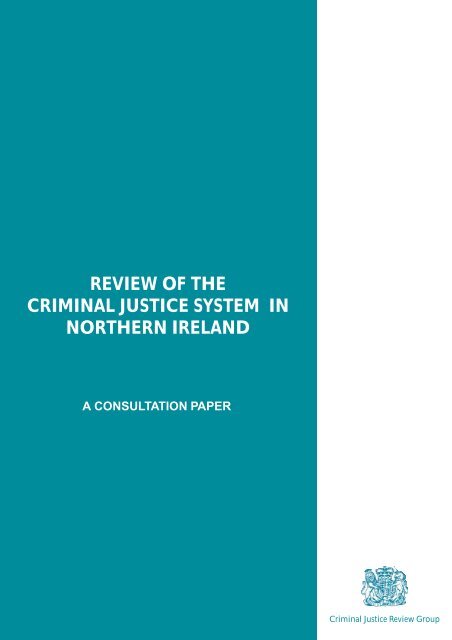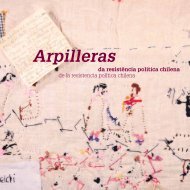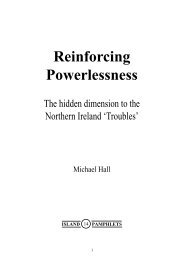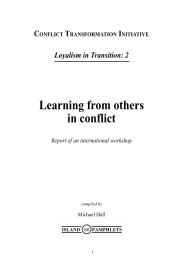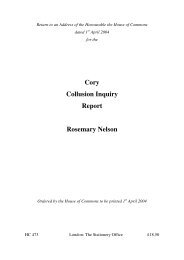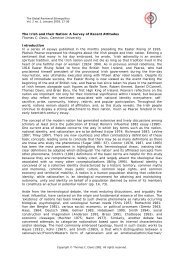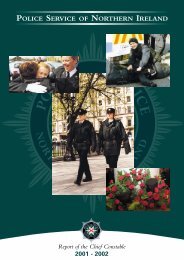Review of the Criminal Justice System in Northern Ireland - CAIN
Review of the Criminal Justice System in Northern Ireland - CAIN
Review of the Criminal Justice System in Northern Ireland - CAIN
- No tags were found...
Create successful ePaper yourself
Turn your PDF publications into a flip-book with our unique Google optimized e-Paper software.
REVIEW OF THECRIMINAL JUSTICE SYSTEM INNORTHERN IRELANDA CONSULTATION PAPER<strong>Crim<strong>in</strong>al</strong> <strong>Justice</strong> <strong>Review</strong> Group
REVIEW OF THECRIMINAL JUSTICE SYSTEM INNORTHERN IRELANDA CONSULTATION PAPERAugust 1998<strong>Crim<strong>in</strong>al</strong> <strong>Justice</strong> <strong>Review</strong> Group
<strong>Review</strong> <strong>of</strong> <strong>Crim<strong>in</strong>al</strong> <strong>Justice</strong> <strong>in</strong> Nor<strong>the</strong>rn <strong>Ireland</strong>A Consultation PaperCONTENTSPAGEForewordChapter 1: Introduction ............................................................................................6Chapter 2:Guid<strong>in</strong>g Pr<strong>in</strong>ciples, Values and Objectives <strong>of</strong> <strong>the</strong>Chapter 3:Chapter 4:Chapter 5:Chapter 6:<strong>Crim<strong>in</strong>al</strong> <strong>Justice</strong> <strong>System</strong>...........................................................................Organisation <strong>of</strong> <strong>the</strong> <strong>Crim<strong>in</strong>al</strong> <strong>Justice</strong> <strong>System</strong>..........................................Improv<strong>in</strong>g Accountability and Responsiveness.......................................<strong>Crim<strong>in</strong>al</strong> <strong>Justice</strong> and <strong>the</strong> Community......................................................The Prosecution Process and <strong>Crim<strong>in</strong>al</strong> Investigations............................812171923Chapter 7: Appo<strong>in</strong>tments to <strong>the</strong> Judiciary and Magistracy ......................................25Chapter 8:Chapter 9:Chapter 10:Law Reform...............................................................................................Co-operation with <strong>Crim<strong>in</strong>al</strong> <strong>Justice</strong> Agencies <strong>in</strong> <strong>the</strong>Republic <strong>of</strong> <strong>Ireland</strong>....................................................................................Conclusion................................................................................................272829Annex A: Members <strong>of</strong> <strong>the</strong> Government <strong>Review</strong> Group...........................................Annex B: Cross-cutt<strong>in</strong>g Comprehensive Spend<strong>in</strong>g <strong>Review</strong> <strong>of</strong><strong>Crim<strong>in</strong>al</strong> <strong>Justice</strong> <strong>in</strong> Nor<strong>the</strong>rn <strong>Ireland</strong>......................................................Annex C: <strong>Crim<strong>in</strong>al</strong> <strong>Justice</strong> <strong>System</strong> <strong>in</strong> Nor<strong>the</strong>rn <strong>Ireland</strong>..........................................Annex D: Government Papers: ‘Crime and Community - A Local PartnershipApproach’ and ‘Restorative <strong>Justice</strong>’..........................................................Annex E: The Court Structure <strong>in</strong> Nor<strong>the</strong>rn <strong>Ireland</strong> ..................................................Annex F: Judicial Appo<strong>in</strong>tments <strong>in</strong> Nor<strong>the</strong>rn <strong>Ireland</strong> .............................................3133373943454
<strong>Review</strong> <strong>of</strong> <strong>Crim<strong>in</strong>al</strong> <strong>Justice</strong> <strong>in</strong> Nor<strong>the</strong>rn <strong>Ireland</strong>A Consultation Paper1Introduction1.1 The Agreement reached <strong>in</strong> Belfast on Good Friday 1998 (Command Paper 3883)provided for a “wide-rang<strong>in</strong>g review <strong>of</strong> crim<strong>in</strong>al justice (o<strong>the</strong>r than polic<strong>in</strong>g andthose aspects <strong>of</strong> <strong>the</strong> system relat<strong>in</strong>g to <strong>the</strong> emergency legislation) to be carried out by<strong>the</strong> British Governmentthrough a mechanism with an<strong>in</strong>dependent element, <strong>in</strong>consultation with <strong>the</strong> politicalparties and o<strong>the</strong>rs”.1.2 That <strong>Review</strong> began on 27 June1998 and is be<strong>in</strong>g carried outby a <strong>Review</strong> Group consist<strong>in</strong>g<strong>of</strong> a small team <strong>of</strong> <strong>of</strong>ficials,represent<strong>in</strong>g <strong>the</strong> Secretary <strong>of</strong>State for Nor<strong>the</strong>rn <strong>Ireland</strong>, <strong>the</strong>Lord Chancellor and <strong>the</strong>Attorney General, assisted by anumber <strong>of</strong> <strong>in</strong>dependentassessors who br<strong>in</strong>g expertise <strong>in</strong><strong>the</strong> crim<strong>in</strong>al justice field andobjectivity, and who willparticipate fully <strong>in</strong> <strong>the</strong> <strong>Review</strong>.The <strong>Review</strong> Group will reportto <strong>the</strong> Secretary <strong>of</strong> State forNor<strong>the</strong>rn <strong>Ireland</strong> no later thanAutumn 1999. It will operate<strong>in</strong> parallel with, but separatelyfrom, <strong>the</strong> <strong>in</strong>dependentCommission on Polic<strong>in</strong>g <strong>in</strong>Nor<strong>the</strong>rn <strong>Ireland</strong>. A list <strong>of</strong>those <strong>in</strong>volved <strong>in</strong> <strong>the</strong> <strong>Review</strong> isattached at Annex A.1.3 This paper seeks views on arange <strong>of</strong> issues with<strong>in</strong> <strong>the</strong>crim<strong>in</strong>al justice system <strong>in</strong>Nor<strong>the</strong>rn <strong>Ireland</strong>. Its purposeis to stimulate discussion withand between political parties,<strong>the</strong> crim<strong>in</strong>al justice agencies,<strong>the</strong> wider public sector, <strong>the</strong>TERMS OF REFERENCETak<strong>in</strong>g account <strong>of</strong> <strong>the</strong> aims <strong>of</strong> <strong>the</strong> crim<strong>in</strong>al justice systemas set out <strong>in</strong> <strong>the</strong> Agreement, <strong>the</strong> <strong>Review</strong> will address <strong>the</strong>structure, management and resourc<strong>in</strong>g <strong>of</strong> <strong>the</strong> publiclyfunded elements <strong>of</strong> <strong>the</strong> crim<strong>in</strong>al justice system (o<strong>the</strong>rthan polic<strong>in</strong>g and those aspects <strong>of</strong> <strong>the</strong> system relat<strong>in</strong>g toemergency legislation) cover<strong>in</strong>g such issues as:• <strong>the</strong> arrangements for mak<strong>in</strong>g appo<strong>in</strong>tments to <strong>the</strong>judiciary and magistracy, and safeguards forprotect<strong>in</strong>g <strong>the</strong>ir <strong>in</strong>dependence;• <strong>the</strong> arrangements for <strong>the</strong> organisation andsupervision <strong>of</strong> <strong>the</strong> prosecution process, and forsafeguard<strong>in</strong>g its <strong>in</strong>dependence;• measures to improve <strong>the</strong> responsiveness andaccountability <strong>of</strong>, and any lay participation <strong>in</strong> <strong>the</strong>crim<strong>in</strong>al justice system;• mechanisms for address<strong>in</strong>g law reform;• <strong>the</strong> scope for structured co-operation between <strong>the</strong>crim<strong>in</strong>al justice agencies on both parts <strong>of</strong> <strong>the</strong> island;and• <strong>the</strong> structure and organisation <strong>of</strong> crim<strong>in</strong>al justicefunctions that might be devolved to an Assembly,<strong>in</strong>clud<strong>in</strong>g <strong>the</strong> possibility <strong>of</strong> establish<strong>in</strong>g a Department<strong>of</strong> <strong>Justice</strong>, while safeguard<strong>in</strong>g <strong>the</strong> essential<strong>in</strong>dependence <strong>of</strong> many <strong>of</strong> <strong>the</strong> key functions <strong>in</strong> thisarea.The Government proposes to commence <strong>the</strong> <strong>Review</strong> assoon as possible, consult<strong>in</strong>g with <strong>the</strong> political parties ando<strong>the</strong>rs,<strong>in</strong>clud<strong>in</strong>g non-governmental expert organisations.The <strong>Review</strong> will be completed by Autumn 1999.community and voluntary sectors, and <strong>in</strong>dividual members <strong>of</strong> <strong>the</strong> public. Thereview process will <strong>in</strong>clude an exam<strong>in</strong>ation <strong>of</strong> relevant experience from elsewhereand <strong>the</strong> commission<strong>in</strong>g <strong>of</strong> research, both comparative and with<strong>in</strong> Nor<strong>the</strong>rn <strong>Ireland</strong>.1.4 The <strong>Review</strong> will work with<strong>in</strong> a broad <strong>in</strong>terpretation <strong>of</strong> what constitutes <strong>the</strong> crim<strong>in</strong>aljustice system <strong>in</strong> Nor<strong>the</strong>rn <strong>Ireland</strong>. Structurally <strong>the</strong> crim<strong>in</strong>al justice system has manyelements, <strong>in</strong>clud<strong>in</strong>g publicly-funded bodies, voluntary and community groups, <strong>the</strong>6
<strong>Review</strong> <strong>of</strong> <strong>Crim<strong>in</strong>al</strong> <strong>Justice</strong> <strong>in</strong> Nor<strong>the</strong>rn <strong>Ireland</strong>A Consultation Paperlegal pr<strong>of</strong>ession, as well as defendants, victims and witnesses. The crim<strong>in</strong>al justicesystem exists to deal with crime <strong>in</strong> all its elements. It is a major, but not <strong>the</strong> onlycomponent <strong>of</strong> <strong>the</strong> response to crime, which <strong>in</strong>volves all <strong>of</strong> society and many spheres<strong>of</strong> Government activity.1.5 The scope <strong>of</strong> this paper is wide, cover<strong>in</strong>g such diverse issues as: <strong>the</strong> purpose <strong>of</strong> <strong>the</strong>crim<strong>in</strong>al justice system and how its success can be measured; <strong>the</strong> structure andorganisation <strong>of</strong> crim<strong>in</strong>al justice functions; questions <strong>of</strong> accountability andresponsiveness; crim<strong>in</strong>al justice and <strong>the</strong> community; <strong>the</strong> prosecution and<strong>in</strong>vestigative processes; appo<strong>in</strong>tments to <strong>the</strong> judiciary and magistracy; arrangementsfor law reform; and co-operation with agencies <strong>in</strong> <strong>the</strong> Republic <strong>of</strong> <strong>Ireland</strong>. But <strong>the</strong>reare <strong>in</strong>evitably a wide range <strong>of</strong> important crim<strong>in</strong>al justice issues not covered here.Polic<strong>in</strong>g <strong>in</strong> general and those aspects <strong>of</strong> <strong>the</strong> system relat<strong>in</strong>g to <strong>the</strong> emergencylegislation are excluded from <strong>the</strong> terms <strong>of</strong> reference <strong>of</strong> <strong>the</strong> <strong>Review</strong>, because <strong>the</strong>y arebe<strong>in</strong>g dealt with by <strong>the</strong> <strong>in</strong>dependent Commission on Polic<strong>in</strong>g and by a separate UKwidereview respectively.1.6 The <strong>Review</strong> will not address <strong>the</strong> operation <strong>of</strong> civil justice matters <strong>in</strong> <strong>the</strong>mselves.There are, however, aspects <strong>of</strong> <strong>the</strong> adm<strong>in</strong>istration <strong>of</strong> justice which have implicationsfor <strong>the</strong> civil and crim<strong>in</strong>al systems, such as <strong>the</strong> adm<strong>in</strong>istration <strong>of</strong> <strong>the</strong> courts, and <strong>the</strong>appo<strong>in</strong>tments and tra<strong>in</strong><strong>in</strong>g <strong>of</strong> <strong>the</strong> judiciary. Such matters will fall with<strong>in</strong> <strong>the</strong><strong>Review</strong>’s remit.1.7 All o<strong>the</strong>r aspects <strong>of</strong> <strong>the</strong> system may be considered, although, given <strong>the</strong> time andresources available to it, <strong>the</strong> <strong>Review</strong> will <strong>in</strong>evitably concentrate on broad issues <strong>of</strong>pr<strong>in</strong>ciple, management and structure ra<strong>the</strong>r than detailed policy matters. The paperdescribes current arrangements and responsibilities and <strong>of</strong>fers for discussion someoptions for change. O<strong>the</strong>r ideas would be welcome: <strong>the</strong> paper merely starts peopleth<strong>in</strong>k<strong>in</strong>g. The <strong>Review</strong> Group would welcome views on whe<strong>the</strong>r additional topics andoptions not covered by this paper should be considered by <strong>the</strong> <strong>Review</strong>.1.8 This <strong>Review</strong> takes place after <strong>the</strong> completion <strong>of</strong> ano<strong>the</strong>r exam<strong>in</strong>ation <strong>of</strong> <strong>the</strong> crim<strong>in</strong>aljustice system <strong>in</strong> Nor<strong>the</strong>rn <strong>Ireland</strong>. As part <strong>of</strong> <strong>the</strong> Comprehensive Spend<strong>in</strong>g <strong>Review</strong><strong>of</strong> all Government Departments and programmes <strong>in</strong>itiated by <strong>the</strong> Government <strong>in</strong><strong>the</strong> summer <strong>of</strong> 1997, <strong>the</strong> Secretary <strong>of</strong> State for Nor<strong>the</strong>rn <strong>Ireland</strong>, with <strong>the</strong> approval<strong>of</strong> <strong>the</strong> Lord Chancellor and Attorney General, <strong>in</strong>stigated an additional ‘cross-cutt<strong>in</strong>g’review <strong>of</strong> <strong>the</strong> crim<strong>in</strong>al justice system <strong>in</strong> Nor<strong>the</strong>rn <strong>Ireland</strong>. It was <strong>the</strong> first review toexam<strong>in</strong>e <strong>the</strong> Nor<strong>the</strong>rn <strong>Ireland</strong> crim<strong>in</strong>al justice system <strong>in</strong> <strong>the</strong> round and was focusedon mak<strong>in</strong>g that system more effective, efficient and cohesive, <strong>in</strong> particular throughenhanced co-operation and co-ord<strong>in</strong>ation between <strong>the</strong> crim<strong>in</strong>al justice agencies.The cross-cutt<strong>in</strong>g review was referred to <strong>in</strong> a statement by <strong>the</strong> Secretary <strong>of</strong> State forNor<strong>the</strong>rn <strong>Ireland</strong> on <strong>the</strong> outcome <strong>of</strong> <strong>the</strong> Comprehensive Spend<strong>in</strong>g <strong>Review</strong>. Annex Bsets out <strong>the</strong> background to <strong>the</strong> review, its ma<strong>in</strong> recommendations, and progress todate.1.9 Many <strong>of</strong> <strong>the</strong> recommendations conta<strong>in</strong>ed <strong>in</strong> <strong>the</strong> cross-cutt<strong>in</strong>g review, for example on<strong>in</strong>formation technology, will be equally applicable no matter how <strong>the</strong> crim<strong>in</strong>aljustice system is structured. However, it is important to emphasise that noth<strong>in</strong>g <strong>in</strong><strong>the</strong> cross-cutt<strong>in</strong>g review should be taken as pre-empt<strong>in</strong>g <strong>the</strong> outcome <strong>of</strong> this exercise.7
<strong>Review</strong> <strong>of</strong> <strong>Crim<strong>in</strong>al</strong> <strong>Justice</strong> <strong>in</strong> Nor<strong>the</strong>rn <strong>Ireland</strong>A Consultation Paper2Guid<strong>in</strong>g Pr<strong>in</strong>ciples, Values and Objectives <strong>of</strong> <strong>the</strong><strong>Crim<strong>in</strong>al</strong> <strong>Justice</strong> <strong>System</strong>2.1 As a start<strong>in</strong>g po<strong>in</strong>t, it is important to have a shared vision across <strong>the</strong> Government,<strong>the</strong> crim<strong>in</strong>al justice agencies and <strong>the</strong> community <strong>of</strong> what we want from <strong>the</strong> crim<strong>in</strong>aljustice system and how we want it to operate. A number <strong>of</strong> organisations with<strong>in</strong> <strong>the</strong>crim<strong>in</strong>al justice system have mission statements, values, and strategic aims andobjectives which <strong>in</strong>form <strong>the</strong>ir plann<strong>in</strong>g processes and set standards to guide <strong>the</strong>iractions. It makes sense to have an agreed set <strong>of</strong> pr<strong>in</strong>ciples and values for <strong>the</strong>crim<strong>in</strong>al justice system as a whole, as a basis for plann<strong>in</strong>g and aga<strong>in</strong>st whichproposals and ideas can be benchmarked. There are also <strong>in</strong>ternational humanrights and norms to which <strong>the</strong> crim<strong>in</strong>al justice system must conform. This need willtake on added significance with <strong>the</strong> passage <strong>of</strong> <strong>the</strong> current Human Rights Bill, whichwill <strong>in</strong>corporate <strong>the</strong> provisions <strong>of</strong> <strong>the</strong> European Convention on Human Rights <strong>in</strong>todomestic law.2.2 Paragraph 4 <strong>of</strong> <strong>the</strong> “Polic<strong>in</strong>g and <strong>Justice</strong>” section <strong>of</strong> <strong>the</strong> Agreement sets out what <strong>the</strong>talks participants believed to be <strong>the</strong> aims <strong>of</strong> <strong>the</strong> crim<strong>in</strong>al justice system.PARAGRAPH 4 OF THE “POLICING AND JUSTICE”SECTION OF THE AGREEMENTThe participants believe that <strong>the</strong> aims <strong>of</strong> <strong>the</strong> crim<strong>in</strong>al justice system are to:• deliver a fair and impartial system <strong>of</strong> justice to <strong>the</strong> community;• be responsive to <strong>the</strong> community’s concerns, and encourag<strong>in</strong>g community <strong>in</strong>volvement whereappropriate;• have <strong>the</strong> confidence <strong>of</strong> all parts <strong>of</strong> <strong>the</strong> community;and• deliver justice efficiently and effectively.2.3 The cross-cutt<strong>in</strong>g review produced a ra<strong>the</strong>r more detailed draft set <strong>of</strong> guid<strong>in</strong>gpr<strong>in</strong>ciples and values which could provide a touchstone aga<strong>in</strong>st which specificpolicies and procedures might be exam<strong>in</strong>ed. These are reproduced below. Theywere seen very much as a first draft to be ref<strong>in</strong>ed at a later stage <strong>in</strong> <strong>the</strong> light <strong>of</strong>consultation. It follows that this <strong>Review</strong> is <strong>in</strong> no way bound by <strong>the</strong>ir terms, but <strong>the</strong>ydo provide a start<strong>in</strong>g po<strong>in</strong>t for discussion.8
<strong>Review</strong> <strong>of</strong> <strong>Crim<strong>in</strong>al</strong> <strong>Justice</strong> <strong>in</strong> Nor<strong>the</strong>rn <strong>Ireland</strong>A Consultation PaperGUIDING PRINCIPLES: A DRAFTThe crim<strong>in</strong>al justice system exists to uphold <strong>the</strong> rule <strong>of</strong> law.The crim<strong>in</strong>al justice system is concerned with crime<strong>in</strong> all its elements and <strong>the</strong> process which br<strong>in</strong>gs <strong>of</strong>fenders to account, but constitutes only a part <strong>of</strong> society’sresponse to crime.The guid<strong>in</strong>g pr<strong>in</strong>ciples <strong>of</strong> <strong>the</strong> publicly funded elements <strong>of</strong> <strong>the</strong> system are:• to deliver a fair system <strong>of</strong> justice to <strong>the</strong> community;• to ensure <strong>the</strong> prompt and just treatment <strong>of</strong> those suspected, accused or convicted <strong>of</strong> crime;• to br<strong>in</strong>g <strong>of</strong>fenders to account;• where prosecutions ensue, to ensure a fair trial before an <strong>in</strong>dependent and impartial tribunal with<strong>in</strong> areasonable time, and to convict <strong>the</strong> guilty and to acquit o<strong>the</strong>rwise; and to ma<strong>in</strong>ta<strong>in</strong> a proper appellatesystem;• to work to prevent <strong>in</strong>dividuals from <strong>of</strong>fend<strong>in</strong>g and sentence those proven guilty <strong>in</strong> a just and proportionatemanner, while seek<strong>in</strong>g to reduce <strong>the</strong> risk <strong>of</strong> fur<strong>the</strong>r <strong>of</strong>fend<strong>in</strong>g;• to be responsive to <strong>the</strong> community’s concerns, and to encourage community <strong>in</strong>volvement where appropriate;• to work, <strong>in</strong> conjunction with <strong>the</strong> community, to reduce crime, m<strong>in</strong>imise <strong>the</strong> fear <strong>of</strong> crime and enhancecommunity safety;• to have regard to <strong>the</strong> proper concerns <strong>of</strong> victims <strong>of</strong> crime;• to ensure witnesses and jurors can perform <strong>the</strong>ir roles free from harassment or <strong>in</strong>timidation;• to act <strong>in</strong> all <strong>in</strong>stances to enhance <strong>the</strong> effectiveness, efficiency and economy <strong>of</strong> <strong>the</strong> system;and• to encourage <strong>the</strong> use <strong>of</strong> <strong>the</strong> civil justice system as a remedy <strong>in</strong> appropriate cases.VALUES: A PRELIMINARY DRAFTThe common values to which <strong>the</strong> publicly funded elements with<strong>in</strong> <strong>the</strong> crim<strong>in</strong>al justice system adhere are:• ma<strong>in</strong>tenance <strong>of</strong> <strong>the</strong> rule <strong>of</strong> law;• protection <strong>of</strong> <strong>in</strong>dividual rights and freedoms under <strong>the</strong> law;• fairness to all, regardless <strong>of</strong> gender, ethnic orig<strong>in</strong>, religion, political op<strong>in</strong>ion, age, disability or sexualorientation;• ma<strong>in</strong>tenance <strong>of</strong> a crim<strong>in</strong>al justice process that is as open, simple, transparent, <strong>in</strong>clusive, and accessible, aspossible;• respect for <strong>the</strong> <strong>in</strong>dependence <strong>of</strong> decision mak<strong>in</strong>g <strong>of</strong> <strong>the</strong> police, <strong>the</strong> prosecut<strong>in</strong>g authorities and <strong>the</strong> judiciary<strong>in</strong> relation to operational matters, decisions on whe<strong>the</strong>r to prosecute, and judicial functions respectively;• assurance <strong>of</strong> public accountability for <strong>the</strong> performance <strong>of</strong> <strong>the</strong> system without compromis<strong>in</strong>g thatessential <strong>in</strong>dependence;• recognition <strong>of</strong> <strong>the</strong> proper <strong>in</strong>dependence <strong>of</strong> action <strong>of</strong> <strong>the</strong> various parts <strong>of</strong> <strong>the</strong> crim<strong>in</strong>al justice system, <strong>in</strong>clud<strong>in</strong>g<strong>the</strong> judiciary;• partnership between <strong>the</strong> crim<strong>in</strong>al justice system, <strong>the</strong> community, and o<strong>the</strong>r external bodies;and• behaviour that promotes public confidence <strong>in</strong> <strong>the</strong> crim<strong>in</strong>al justice system.9
<strong>Review</strong> <strong>of</strong> <strong>Crim<strong>in</strong>al</strong> <strong>Justice</strong> <strong>in</strong> Nor<strong>the</strong>rn <strong>Ireland</strong>A Consultation Paper2.4 The cross-cutt<strong>in</strong>g review recognised, however, that <strong>in</strong> <strong>the</strong>mselves <strong>the</strong> pr<strong>in</strong>ciples andvalues are nei<strong>the</strong>r measurable nor sufficient for <strong>the</strong> public to hold <strong>the</strong> system toaccount. For that to be possible, specific objectives and key performance <strong>in</strong>dicatorsneed to be developed. This process should clearly identify <strong>the</strong> priorities <strong>of</strong> <strong>the</strong>public and <strong>of</strong> M<strong>in</strong>isters and allow <strong>the</strong>m to determ<strong>in</strong>e how well <strong>the</strong> crim<strong>in</strong>al justicesystem has performed. This is an additional process complementary to <strong>the</strong> sett<strong>in</strong>g <strong>of</strong>objectives by each organisation.2.5 The process <strong>of</strong> establish<strong>in</strong>g system-wide objectives is not an easy one. There is <strong>the</strong>danger <strong>of</strong> creat<strong>in</strong>g perverse <strong>in</strong>centives or ones which are liable to mis<strong>in</strong>terpretation.For example, achiev<strong>in</strong>g <strong>the</strong> objective <strong>of</strong> reduc<strong>in</strong>g reported crime levels could reflectbetter prevention, or could simply reflect lower report<strong>in</strong>g as a result <strong>of</strong> lowerconfidence <strong>in</strong> <strong>the</strong> organisations responsible for crime prevention, detection andadjudication. Any s<strong>in</strong>gle <strong>in</strong>dicator is vulnerable when taken <strong>in</strong> isolation; so anetwork <strong>of</strong> <strong>in</strong>dicators address<strong>in</strong>g <strong>the</strong> various requirements exam<strong>in</strong>ed <strong>in</strong> <strong>the</strong> roundmight be preferable. In addition, a balance needs to be struck between <strong>the</strong> stabilitynecessary to judge aga<strong>in</strong>st common criteria over time and <strong>the</strong> need to reflectdevelop<strong>in</strong>g priorities.2.6 An illustrative framework for objectives is put forward as a start<strong>in</strong>g po<strong>in</strong>t forconsideration. Performance measures or <strong>in</strong>dicators will be central to giv<strong>in</strong>g effect to<strong>the</strong> f<strong>in</strong>al set <strong>of</strong> objectives. Measur<strong>in</strong>g <strong>the</strong> extent to which <strong>the</strong>se objectives areachieved should be a critical part <strong>of</strong> any accountability process and <strong>the</strong> <strong>Review</strong> willseek views on devis<strong>in</strong>g mean<strong>in</strong>gful and reliable forms <strong>of</strong> measurement.ILLUSTRATIVE FRAMEWORK FOR OBJECTIVESTO REDUCE CRIME AND DISORDER1. Seek to reduce levels <strong>of</strong> crime and major disorder;2. Reduce numbers re<strong>of</strong>fend<strong>in</strong>g and frequency for persistent <strong>of</strong>fenders;3. Reduce levels <strong>of</strong> fear <strong>of</strong> crime.TO BRING OFFENDERS JUSTLY TO ACCOUNT4. Increase <strong>the</strong> number <strong>of</strong> notified crimes cleared and <strong>of</strong>fenders brought to account;5. Ensure <strong>the</strong> development <strong>of</strong> crim<strong>in</strong>al justice processes and outcomes which are fair and just, andwhich are seen to be so.TO IMPROVE THE SERVICE DELIVERED6. Improve <strong>the</strong> speed <strong>of</strong> case completion and levels <strong>of</strong> effectiveness, efficiency and co-operation with<strong>in</strong><strong>the</strong> system;7. Enhance <strong>the</strong> service provided to victims, witnesses and jurors;8. Enhance public confidence <strong>in</strong> <strong>the</strong> crim<strong>in</strong>al justice system.2.7 The Police (Nor<strong>the</strong>rn <strong>Ireland</strong>) Act 1998 provides that objectives for <strong>the</strong> policeservice be published annually. Performance aga<strong>in</strong>st <strong>the</strong>se objectives will also bemeasured and reported. The cross-cutt<strong>in</strong>g review similarly recommended thatobjectives for <strong>the</strong> crim<strong>in</strong>al justice system should be published and that an annualreport <strong>of</strong> performance aga<strong>in</strong>st objectives should be prepared.10
<strong>Review</strong> <strong>of</strong> <strong>Crim<strong>in</strong>al</strong> <strong>Justice</strong> <strong>in</strong> Nor<strong>the</strong>rn <strong>Ireland</strong>A Consultation Paper2.8 Views and comments are sought on what would be <strong>the</strong> appropriate pr<strong>in</strong>ciples, valuesand objectives for <strong>the</strong> crim<strong>in</strong>al justice system. For example:• What do you want from <strong>the</strong> crim<strong>in</strong>al justice system?• What pr<strong>in</strong>ciples and values should guide <strong>the</strong> delivery <strong>of</strong> its services? Is it right toassume <strong>the</strong> start<strong>in</strong>g po<strong>in</strong>t should be what <strong>the</strong> public and Government expect <strong>the</strong>system to deliver?• Should <strong>the</strong> pr<strong>in</strong>ciples and values reflect more clearly <strong>the</strong> role and responsibility <strong>of</strong><strong>the</strong> voluntary sector?• Would <strong>the</strong>re be merit <strong>in</strong> enshr<strong>in</strong><strong>in</strong>g <strong>the</strong> pr<strong>in</strong>ciples and values <strong>in</strong> legislation?• What do you th<strong>in</strong>k <strong>the</strong> objectives <strong>of</strong> <strong>the</strong> crim<strong>in</strong>al justice system should be?• How would you measure <strong>the</strong>ir achievement?• Should <strong>the</strong> objectives and <strong>the</strong>ir outcomes be published annually?11
<strong>Review</strong> <strong>of</strong> <strong>Crim<strong>in</strong>al</strong> <strong>Justice</strong> <strong>in</strong> Nor<strong>the</strong>rn <strong>Ireland</strong>A Consultation Paper3.5 The Secretary <strong>of</strong> State for Nor<strong>the</strong>rn <strong>Ireland</strong> has responsibility for <strong>the</strong> content <strong>of</strong> <strong>the</strong>crim<strong>in</strong>al law <strong>in</strong> Nor<strong>the</strong>rn <strong>Ireland</strong> and for <strong>the</strong> overall effectiveness <strong>of</strong> <strong>the</strong> crim<strong>in</strong>aljustice system. She also has responsibility for polic<strong>in</strong>g, prisons, probation, policy onvictims, crime prevention, community safety, juvenile justice, crim<strong>in</strong>alcompensation, forensic science, State Pathology, and co-ord<strong>in</strong>at<strong>in</strong>g anti-drugsactivity. Until 1997 <strong>the</strong> Secretary <strong>of</strong> State for Nor<strong>the</strong>rn <strong>Ireland</strong> was responsible forconsider<strong>in</strong>g alleged miscarriages <strong>of</strong> justice and for referr<strong>in</strong>g cases back to <strong>the</strong> Court<strong>of</strong> Appeal, where appropriate. On 31 March 1997 <strong>the</strong>se responsibilities <strong>in</strong> Nor<strong>the</strong>rn<strong>Ireland</strong> and England and Wales passed to <strong>the</strong> <strong>in</strong>dependent <strong>Crim<strong>in</strong>al</strong> Cases <strong>Review</strong>Commission.RESPONSIBILITIES OF THE SECRETARY OFSTATE FOR NORTHERN IRELAND• <strong>Crim<strong>in</strong>al</strong> law and procedure, measures to enhance co-operation and co-ord<strong>in</strong>ation <strong>in</strong> <strong>the</strong> crim<strong>in</strong>aljustice system, crime prevention policy and co-ord<strong>in</strong>ation, policy on victims, and <strong>the</strong> provision <strong>of</strong>certa<strong>in</strong> juvenile justice services.• Security policy, <strong>in</strong>clud<strong>in</strong>g <strong>the</strong> emergency legislation <strong>in</strong> Nor<strong>the</strong>rn <strong>Ireland</strong>, public order policy andlegislation.• Polic<strong>in</strong>g policy, legislation and <strong>the</strong> resource framework with<strong>in</strong> which polic<strong>in</strong>g is delivered.• The Nor<strong>the</strong>rn <strong>Ireland</strong> Prison Service, responsible for prison adm<strong>in</strong>istration, and for release policy,<strong>in</strong>clud<strong>in</strong>g <strong>the</strong> discretionary release <strong>of</strong> life sentence prisoners.• The Probation Board for Nor<strong>the</strong>rn <strong>Ireland</strong>, responsible for ma<strong>in</strong>ta<strong>in</strong><strong>in</strong>g an efficient probation service<strong>in</strong> Nor<strong>the</strong>rn <strong>Ireland</strong>.• The Forensic Science Agency for Nor<strong>the</strong>rn <strong>Ireland</strong>, Compensation Agency, and State Pathology.• The provision <strong>of</strong> staff, <strong>of</strong>fices and o<strong>the</strong>r resources for <strong>the</strong> Director <strong>of</strong> Public Prosecutions forNor<strong>the</strong>rn <strong>Ireland</strong>.3.6 The Secretary <strong>of</strong> State is also responsible for <strong>the</strong> provision <strong>of</strong> certa<strong>in</strong> facilities andservices to enable sentences <strong>of</strong> <strong>the</strong> courts to be carried out, <strong>in</strong>clud<strong>in</strong>g prisons,probation and juvenile justice arrangements. The Nor<strong>the</strong>rn <strong>Ireland</strong> Prison Service isa Next Steps Agency with<strong>in</strong> <strong>the</strong> Nor<strong>the</strong>rn <strong>Ireland</strong> Office, with a Director Generalresponsible to <strong>the</strong> Secretary <strong>of</strong> State for efficient and effective service provision.Probation is run by an <strong>in</strong>dependent Board (a non-departmental public body),appo<strong>in</strong>ted by <strong>the</strong> Secretary <strong>of</strong> State, with<strong>in</strong> a strategic framework set by her. Thisarrangement was recently endorsed by M<strong>in</strong>isters follow<strong>in</strong>g a qu<strong>in</strong>quennial review.Juvenile justice arrangements have been <strong>the</strong> subject <strong>of</strong> legislative change and <strong>the</strong><strong>in</strong>troduction <strong>of</strong> a new strategic approach, <strong>in</strong>tended to place more emphasis ondivert<strong>in</strong>g children away from <strong>the</strong> crim<strong>in</strong>al justice system and custody. For those fewchildren whose <strong>of</strong>fend<strong>in</strong>g behaviour warrants custody, <strong>the</strong>re will <strong>in</strong> future bedeterm<strong>in</strong>ate sentences, half served <strong>in</strong> juvenile justice centres funded by <strong>the</strong> Nor<strong>the</strong>rn<strong>Ireland</strong> Office, and half served <strong>in</strong> <strong>the</strong> community under supervision organised by <strong>the</strong>Probation Service.13
<strong>Review</strong> <strong>of</strong> <strong>Crim<strong>in</strong>al</strong> <strong>Justice</strong> <strong>in</strong> Nor<strong>the</strong>rn <strong>Ireland</strong>A Consultation Paper3.7 The release <strong>of</strong> determ<strong>in</strong>ate sentence prisoners is governed by statute. They arereleased automatically at <strong>the</strong> half way po<strong>in</strong>t <strong>of</strong> sentence ei<strong>the</strong>r on remission or, <strong>in</strong><strong>the</strong> case <strong>of</strong> prisoners released under <strong>the</strong> Nor<strong>the</strong>rn <strong>Ireland</strong> (Remission <strong>of</strong> SentencesAct) 1995, on unsupervised licence. There is no Parole Board <strong>in</strong> Nor<strong>the</strong>rn <strong>Ireland</strong>nor, with <strong>the</strong> exception <strong>in</strong> certa<strong>in</strong> circumstances <strong>of</strong> sex <strong>of</strong>fenders, are determ<strong>in</strong>atesentence prisoners subject to statutory supervision after release.3.8 The release on licence <strong>of</strong> life sentence prisoners and prisoners held dur<strong>in</strong>g <strong>the</strong>pleasure <strong>of</strong> <strong>the</strong> Secretary <strong>of</strong> State is at <strong>the</strong> discretion <strong>of</strong> <strong>the</strong> Secretary <strong>of</strong> Statefollow<strong>in</strong>g consultation with <strong>the</strong> Lord Chief <strong>Justice</strong> <strong>of</strong> Nor<strong>the</strong>rn <strong>Ireland</strong> and, ifavailable, <strong>the</strong> trial judge. The Secretary <strong>of</strong> State is formally advised by <strong>the</strong> nonstatutoryLife Sentence <strong>Review</strong> Board which is made up <strong>of</strong> senior Nor<strong>the</strong>rn <strong>Ireland</strong>Office and Nor<strong>the</strong>rn <strong>Ireland</strong> Prison Service <strong>of</strong>ficials and which is advised by <strong>the</strong>Chief Probation Officer and a consultant forensic psychiatrist. Changes <strong>in</strong> lifesentence review and release arrangements are currently be<strong>in</strong>g considered with<strong>in</strong> <strong>the</strong>Nor<strong>the</strong>rn <strong>Ireland</strong> Office.3.9 The Nor<strong>the</strong>rn <strong>Ireland</strong> (Sentences) Act 1998 aris<strong>in</strong>g out <strong>of</strong> <strong>the</strong> Belfast Agreement willput <strong>in</strong> place new arrangements for <strong>the</strong> release <strong>of</strong> prisoners given sentences <strong>of</strong> 5 yearsor more, <strong>in</strong>clud<strong>in</strong>g life, for scheduled <strong>of</strong>fences committed before 10 April 1998.3.10 In addition <strong>the</strong> Secretary <strong>of</strong> State is responsible for civil law reform, which isdelivered by <strong>the</strong> Office <strong>of</strong> Law Reform with<strong>in</strong> <strong>the</strong> Department <strong>of</strong> F<strong>in</strong>ance andPersonnel. As such it will fall with<strong>in</strong> <strong>the</strong> ambit <strong>of</strong> M<strong>in</strong>isters responsible to <strong>the</strong>Nor<strong>the</strong>rn <strong>Ireland</strong> Assembly once <strong>the</strong>y take responsibility for <strong>the</strong> Nor<strong>the</strong>rn <strong>Ireland</strong>Departments.3.11 The Attorney General is <strong>the</strong> chief law <strong>of</strong>ficer <strong>of</strong> <strong>the</strong> Government, with responsibilityfor advis<strong>in</strong>g government departments and represent<strong>in</strong>g <strong>the</strong> Government’s <strong>in</strong>terest <strong>in</strong>important legal disputes. In Nor<strong>the</strong>rn <strong>Ireland</strong> he appo<strong>in</strong>ts a Director and deputyDirector <strong>of</strong> Public Prosecutions, and may remove <strong>the</strong>m from <strong>of</strong>fice on <strong>the</strong> grounds<strong>of</strong> <strong>in</strong>ability or misbehaviour. The Director <strong>of</strong> Public Prosecutions for Nor<strong>the</strong>rn<strong>Ireland</strong> acts under <strong>the</strong> super<strong>in</strong>tendence and direction <strong>of</strong> <strong>the</strong> Attorney General. Thefunctions <strong>of</strong> <strong>the</strong> Director <strong>of</strong> Public Prosecutions for Nor<strong>the</strong>rn <strong>Ireland</strong> are set ou<strong>the</strong>re. The RUC prosecute less serious <strong>of</strong>fences <strong>in</strong> <strong>the</strong> magistrates’ courts.FUNCTIONS OF THE DIRECTOR OF PUBLICPROSECUTIONS FOR NORTHERN IRELANDThe Director <strong>of</strong> Public Prosecutions for Nor<strong>the</strong>rn <strong>Ireland</strong> is responsible for:• <strong>in</strong>itiat<strong>in</strong>g and undertak<strong>in</strong>g prosecutions, <strong>in</strong>clud<strong>in</strong>g prosecutions‘ <strong>in</strong> all Crown Court cases, andprosecution <strong>of</strong> more serious cases <strong>in</strong> <strong>the</strong> magistrates’courts;• act<strong>in</strong>g on behalf <strong>of</strong> <strong>the</strong> Crown <strong>in</strong> bail applications;• act<strong>in</strong>g on behalf <strong>of</strong> <strong>the</strong> Crown <strong>in</strong> crim<strong>in</strong>al proceed<strong>in</strong>gs <strong>in</strong> <strong>the</strong> County Court, <strong>in</strong> <strong>the</strong> Court <strong>of</strong> Appealand <strong>the</strong> House <strong>of</strong> Lords.14
<strong>Review</strong> <strong>of</strong> <strong>Crim<strong>in</strong>al</strong> <strong>Justice</strong> <strong>in</strong> Nor<strong>the</strong>rn <strong>Ireland</strong>A Consultation Paper3.12 The Lord Chancellor is a Government M<strong>in</strong>ister, <strong>the</strong> Speaker <strong>of</strong> <strong>the</strong> House <strong>of</strong> Lordswhen it is act<strong>in</strong>g <strong>in</strong> its legislative capacity, and <strong>the</strong> senior judge when <strong>the</strong> House <strong>of</strong>Lords is act<strong>in</strong>g <strong>in</strong> its judicial capacity. He exercises his executive functions <strong>in</strong>Nor<strong>the</strong>rn <strong>Ireland</strong> through <strong>the</strong> Nor<strong>the</strong>rn <strong>Ireland</strong> Court Service, which is a separateand dist<strong>in</strong>ct civil service <strong>of</strong> <strong>the</strong> Crown. He is responsible for all judicial and mosttribunal appo<strong>in</strong>tments (see chapter 7).FUNCTIONS OF THE NORTHERN IRELAND COURT SERVICEThe ma<strong>in</strong> functions <strong>of</strong> <strong>the</strong> Nor<strong>the</strong>rn <strong>Ireland</strong> Court Service are:• facilitat<strong>in</strong>g <strong>the</strong> bus<strong>in</strong>ess <strong>of</strong> <strong>the</strong> Supreme Court, county courts, magistrates’courts, coroners’courtsand certa<strong>in</strong> tribunals;• giv<strong>in</strong>g effect to judgments to which <strong>the</strong> Judgments Enforcement (Nor<strong>the</strong>rn <strong>Ireland</strong>) Order 1981applies (i.e.enforc<strong>in</strong>g money and certa<strong>in</strong> non-money judgments obta<strong>in</strong>ed as a result <strong>of</strong> court oro<strong>the</strong>r tribunal proceed<strong>in</strong>gs on behalf <strong>of</strong> Government Departments, public bodies and o<strong>the</strong>rorganisations and <strong>in</strong>dividuals);and• provid<strong>in</strong>g to <strong>the</strong> Lord Chancellor policy advice and legislative support <strong>in</strong> relation to his M<strong>in</strong>isterialresponsibilities <strong>in</strong> Nor<strong>the</strong>rn <strong>Ireland</strong>, <strong>in</strong>clud<strong>in</strong>g civil and crim<strong>in</strong>al legal aid.3.13 The exist<strong>in</strong>g organisation <strong>of</strong> crim<strong>in</strong>al justice functions and <strong>the</strong> spread <strong>of</strong> politicalaccountability owes much to <strong>the</strong> arrangements for govern<strong>in</strong>g Nor<strong>the</strong>rn <strong>Ireland</strong> s<strong>in</strong>ce1972. The split <strong>in</strong> responsibilities also re<strong>in</strong>forced <strong>the</strong> essential <strong>in</strong>dependence <strong>of</strong>decision tak<strong>in</strong>g <strong>in</strong> key component parts <strong>of</strong> <strong>the</strong> system. Whilst appear<strong>in</strong>gcumbersome <strong>the</strong> organisational arrangements have worked well. It is possible,however, to envisage o<strong>the</strong>r models for organis<strong>in</strong>g crim<strong>in</strong>al justice functions,particularly <strong>in</strong> <strong>the</strong> context <strong>of</strong> devolv<strong>in</strong>g responsibility for some or all <strong>of</strong> <strong>the</strong> abovefunctions to M<strong>in</strong>isters responsible to <strong>the</strong> Nor<strong>the</strong>rn <strong>Ireland</strong> Assembly at some po<strong>in</strong>t<strong>in</strong> <strong>the</strong> future.3.14 In many o<strong>the</strong>r jurisdictions most, if not all, <strong>of</strong> <strong>the</strong> crim<strong>in</strong>al justice functions,toge<strong>the</strong>r with responsibility for civil and crim<strong>in</strong>al law reform, are brought toge<strong>the</strong>rwith<strong>in</strong> a s<strong>in</strong>gle justice department. Some jurisdictions split responsibility forpolic<strong>in</strong>g from o<strong>the</strong>r justice functions <strong>in</strong>to a department <strong>of</strong> <strong>the</strong> <strong>in</strong>terior, <strong>of</strong>ten witho<strong>the</strong>r regulatory functions, such as firearms and explosives control, and gam<strong>in</strong>g,bett<strong>in</strong>g and liquor licens<strong>in</strong>g. O<strong>the</strong>rs ma<strong>in</strong>ta<strong>in</strong> <strong>the</strong> separation <strong>of</strong> responsibility for<strong>the</strong> prosecution function to preserve and protect <strong>the</strong> <strong>in</strong>dependence <strong>of</strong> <strong>the</strong>prosecution process.3.15 In Nor<strong>the</strong>rn <strong>Ireland</strong>’s small jurisdiction and with devolution it is possible toenvisage a number <strong>of</strong> models for deliver<strong>in</strong>g <strong>the</strong>se services and determ<strong>in</strong><strong>in</strong>g <strong>the</strong>relationship between <strong>the</strong>m. In addition, responsibility for a number <strong>of</strong> <strong>in</strong>dividualfunctions can be aggregated <strong>in</strong> different ways. For example <strong>the</strong> delivery <strong>of</strong> prisonservices and supervision <strong>in</strong> <strong>the</strong> community, toge<strong>the</strong>r with <strong>the</strong> necessary co-operationand co-ord<strong>in</strong>ation between <strong>the</strong> functions, can be achieved through a range <strong>of</strong>organisational structures. If structural and organisational changes were to be made,care would have to be taken to ensure that <strong>the</strong>y provided for efficiency and15
<strong>Review</strong> <strong>of</strong> <strong>Crim<strong>in</strong>al</strong> <strong>Justice</strong> <strong>in</strong> Nor<strong>the</strong>rn <strong>Ireland</strong>A Consultation Papereffectiveness, while safeguard<strong>in</strong>g <strong>the</strong> essential <strong>in</strong>dependence <strong>of</strong> many <strong>of</strong> <strong>the</strong> keycrim<strong>in</strong>al justice functions. Also any consideration <strong>of</strong> organisation and structureshould take account <strong>of</strong> <strong>the</strong>ir impact on such matters as <strong>the</strong> community focus <strong>of</strong>probation and <strong>the</strong> degree <strong>of</strong> separation <strong>of</strong> arrangements for juveniles from those foradults.3.16 This <strong>Review</strong> will consider a range <strong>of</strong> o<strong>the</strong>r models for organis<strong>in</strong>g crim<strong>in</strong>al justicefunctions, both elsewhere <strong>in</strong> <strong>the</strong> United K<strong>in</strong>gdom (<strong>in</strong> Scotland, <strong>in</strong> particular, <strong>in</strong> <strong>the</strong>context <strong>of</strong> devolution), <strong>in</strong> <strong>the</strong> Republic <strong>of</strong> <strong>Ireland</strong> and <strong>in</strong>ternationally. It will alsoseek views on whe<strong>the</strong>r aspects <strong>of</strong> <strong>the</strong> Home Office Prisons/Probation report ‘Jo<strong>in</strong><strong>in</strong>gForces to Protect <strong>the</strong> Public’ published on 6 August 1998 might be relevant <strong>in</strong> <strong>the</strong>Nor<strong>the</strong>rn <strong>Ireland</strong> context.3.17 Views on alternatives for <strong>the</strong> structure and organisation <strong>of</strong> crim<strong>in</strong>al justice functionswould be welcome. For example:• Should a justice department be established? What should its role andresponsibilities be? How should its functions be organised?• Should <strong>the</strong> prosecution function be separate from any justice department?• Should <strong>the</strong>re be a Parole Board or any o<strong>the</strong>r body advis<strong>in</strong>g on or oversee<strong>in</strong>g <strong>the</strong>release <strong>of</strong> prisoners?• Should responsibility for <strong>in</strong>vestigat<strong>in</strong>g alleged miscarriages <strong>of</strong> justice cont<strong>in</strong>ue torest with <strong>the</strong> <strong>Crim<strong>in</strong>al</strong> Cases <strong>Review</strong> Commission? Are <strong>the</strong> current arrangementswork<strong>in</strong>g satisfactorily?16
<strong>Review</strong> <strong>of</strong> <strong>Crim<strong>in</strong>al</strong> <strong>Justice</strong> <strong>in</strong> Nor<strong>the</strong>rn <strong>Ireland</strong>A Consultation Paper4Improv<strong>in</strong>g Accountability and Responsiveness4.1 This chapter exam<strong>in</strong>es <strong>the</strong> measures to improve <strong>the</strong> accountability andresponsiveness <strong>of</strong> <strong>the</strong> crim<strong>in</strong>al justice system. The effectiveness <strong>of</strong> <strong>the</strong> crim<strong>in</strong>aljustice system depends upon <strong>the</strong> quality and efficiency <strong>of</strong> service it provides. As <strong>in</strong>o<strong>the</strong>r jurisdictions, <strong>the</strong> crim<strong>in</strong>al justice system <strong>in</strong> Nor<strong>the</strong>rn <strong>Ireland</strong> suffers fromdelay and at times <strong>the</strong>re are questions about whe<strong>the</strong>r resources expended are used tobest effect, both <strong>in</strong> terms <strong>of</strong> reduc<strong>in</strong>g crime and crim<strong>in</strong>ality, and <strong>in</strong> terms <strong>of</strong> <strong>the</strong> way<strong>in</strong> which those who come <strong>in</strong>to contact with <strong>the</strong> system are treated, whe<strong>the</strong>r asvictims, witnesses, jurors or defendants.4.2 The system as a whole needs to be accountable to <strong>the</strong> political structures whichgovern it, and through those structures to society at large. Individual agencies maybe directly or <strong>in</strong>directly accountable to government, at whatever level. O<strong>the</strong>rs, suchas <strong>the</strong> judiciary, are necessarily <strong>in</strong>dependent <strong>in</strong> <strong>the</strong> exercise <strong>of</strong> <strong>the</strong>ir functions, andthat <strong>in</strong>dependence is jealously, and rightly, guarded. The crim<strong>in</strong>al justice systemalso needs to be accountable for <strong>the</strong> proper use <strong>of</strong> f<strong>in</strong>ancial resources, for which<strong>the</strong>re are well established audit systems.4.3 There are o<strong>the</strong>r important forms <strong>of</strong> accountability, whereby agencies are directlyaccountable to <strong>the</strong>ir users <strong>in</strong> <strong>the</strong> exercise <strong>of</strong> some or all <strong>of</strong> <strong>the</strong>ir functions. Publishedannual reports, compla<strong>in</strong>ts mechanisms, scrut<strong>in</strong>y by <strong>in</strong>spectorates, user groups andsurveys, and <strong>the</strong> Citizen’s Charter are all examples <strong>of</strong> mechanisms which aredesigned to improve accountability <strong>of</strong> agencies to <strong>the</strong> community at large, and <strong>the</strong>irusers <strong>in</strong> particular, and to improve <strong>the</strong> responsiveness <strong>of</strong> those agencies to bothsociety and <strong>in</strong>dividuals. The <strong>Review</strong> welcomes views on how best to achieveeffective accountability and will also be tak<strong>in</strong>g account <strong>of</strong> lessons to be learned frombest practice <strong>in</strong> o<strong>the</strong>r jurisdictions.4.4 One mechanism for achiev<strong>in</strong>g <strong>in</strong>dependent scrut<strong>in</strong>y and public accountability isthrough <strong>the</strong> <strong>in</strong>spectorates. In Nor<strong>the</strong>rn <strong>Ireland</strong> <strong>the</strong> RUC and Prison Service aresubject to scrut<strong>in</strong>y by HM Inspectorates on <strong>the</strong> same basis as <strong>in</strong> England and Walesand Scotland, while Probation and <strong>the</strong>Tra<strong>in</strong><strong>in</strong>g Schools are <strong>in</strong>spected byspecialists with<strong>in</strong> <strong>the</strong> Social ServicesInspectorate <strong>of</strong> <strong>the</strong> Department <strong>of</strong>Health and Social Services. For somefunctions at least, <strong>the</strong>re may be a casefor establish<strong>in</strong>g a crim<strong>in</strong>al justice<strong>in</strong>spectorate capable <strong>of</strong> do<strong>in</strong>g somework itself, but also able to buy <strong>in</strong>expertise and use lay assessors asappropriate. This could facilitate aholistic approach to crim<strong>in</strong>al justice,for example through <strong>the</strong>matic<strong>in</strong>spections cross<strong>in</strong>g traditionalpr<strong>of</strong>essional boundaries.EXAMPLES OF CURRENTINSPECTION ACTIVITY• The RUC are <strong>in</strong>spected by HM Inspector <strong>of</strong>Constabulary.• The Probation Service are <strong>in</strong>spected by <strong>the</strong>Nor<strong>the</strong>rn <strong>Ireland</strong> Social ServicesInspectorate.• The Nor<strong>the</strong>rn <strong>Ireland</strong> Prison Service are<strong>in</strong>spected by HM Inspectorate <strong>of</strong> Prisons.17
<strong>Review</strong> <strong>of</strong> <strong>Crim<strong>in</strong>al</strong> <strong>Justice</strong> <strong>in</strong> Nor<strong>the</strong>rn <strong>Ireland</strong>A Consultation Paper4.5 Views and comments on <strong>the</strong>se issues would be welcome. For example:• What mechanisms might agencies use to draw out <strong>the</strong> views <strong>of</strong> <strong>the</strong> community and<strong>in</strong>dividual citizens on <strong>the</strong> services <strong>the</strong>y provide?• What should <strong>the</strong> role and nature <strong>of</strong> <strong>in</strong>dependent scrut<strong>in</strong>y (for example by<strong>in</strong>spectorates) be? Is <strong>the</strong>re a case for new and broader arrangements for <strong>in</strong>spect<strong>in</strong>g<strong>the</strong> crim<strong>in</strong>al justice system?• What more can be done to improve accountability and, <strong>in</strong> particular,responsiveness?18
<strong>Review</strong> <strong>of</strong> <strong>Crim<strong>in</strong>al</strong> <strong>Justice</strong> <strong>in</strong> Nor<strong>the</strong>rn <strong>Ireland</strong>A Consultation Paper5<strong>Crim<strong>in</strong>al</strong> <strong>Justice</strong> and <strong>the</strong> Community5.1 This chapter exam<strong>in</strong>es <strong>the</strong> development <strong>of</strong> partnership approaches to prevent<strong>in</strong>gand deal<strong>in</strong>g with crime, <strong>the</strong> development <strong>of</strong> restorative justice <strong>in</strong> Nor<strong>the</strong>rn <strong>Ireland</strong>,and ways to improve <strong>the</strong> ability <strong>of</strong> <strong>the</strong> crim<strong>in</strong>al justice system to deal with crime andto target its resources more effectively. It notes <strong>the</strong> Government’s work <strong>in</strong> Englandand Wales on vulnerable or <strong>in</strong>timidated witnesses, and sets out how work on thatsubject is be<strong>in</strong>g taken forward <strong>in</strong> Nor<strong>the</strong>rn <strong>Ireland</strong> toge<strong>the</strong>r with o<strong>the</strong>r measures tomeet <strong>the</strong> needs <strong>of</strong> victims.5.2 A central <strong>the</strong>me <strong>of</strong> this <strong>Review</strong> will be to consider how <strong>the</strong> crim<strong>in</strong>al justice systemcan be more sharply focused on <strong>the</strong> needs <strong>of</strong> <strong>the</strong> community, and <strong>the</strong> needs <strong>of</strong> <strong>the</strong>citizen who comes <strong>in</strong>to contact with it, particularly those <strong>of</strong> victims and witnesses.The <strong>Review</strong> will consider how <strong>in</strong>dividual citizens, <strong>the</strong> community and voluntarysectors, and <strong>the</strong> broad resources <strong>of</strong> government at all levels can be engaged <strong>in</strong> apartnership to make <strong>the</strong> community safer by reduc<strong>in</strong>g crim<strong>in</strong>ality, <strong>the</strong> <strong>in</strong>cidence <strong>of</strong>crime and <strong>the</strong> fear <strong>of</strong> crime. Restorative justice, crime prevention, crime reduction,community safety and <strong>the</strong> drugs strategy are all important elements <strong>of</strong> an approachwhich needs to be practical, based on local needs and delivered with <strong>the</strong> activesupport <strong>of</strong> <strong>the</strong> local community. Such work must also be based on best practicewith<strong>in</strong> Nor<strong>the</strong>rn <strong>Ireland</strong> and fur<strong>the</strong>r afield, and based on <strong>the</strong> available researchevidence <strong>of</strong> what works <strong>in</strong> reduc<strong>in</strong>g crime and crim<strong>in</strong>ality.5.3 In March 1998 <strong>the</strong> Government published a paper, ‘Partnership aga<strong>in</strong>st Crime’,based on a Government paper submitted to <strong>the</strong> multi-party talks (reproduced atAnnex D), which affirmed <strong>the</strong> Government’s commitment to a partnershipapproach <strong>in</strong> address<strong>in</strong>g <strong>the</strong> problems <strong>of</strong> crime and anti-social behaviour <strong>in</strong> <strong>the</strong>community. It focused on how Nor<strong>the</strong>rn <strong>Ireland</strong>’s well developed community andvoluntary sectors can work effectively <strong>in</strong> partnership with <strong>the</strong> crim<strong>in</strong>al justice systemand o<strong>the</strong>r statutory agencies <strong>in</strong> help<strong>in</strong>g to tackle <strong>the</strong> problems <strong>of</strong> crime and antisocialbehaviour. It emphasised <strong>the</strong> Government’s commitment to work<strong>in</strong>g <strong>in</strong>partnership with <strong>the</strong> community. The paper welcomed and encouraged <strong>in</strong>novativeideas aimed at empower<strong>in</strong>g communities, <strong>in</strong> partnership with public agencies, toimprove social cohesion, promote social <strong>in</strong>clusion, resolve disputes and address <strong>the</strong>problem <strong>of</strong> crime and <strong>the</strong> fear <strong>of</strong> crime. However it warned that “alternative justicecould not be tolerated” and stressed that <strong>the</strong> formal processes <strong>of</strong> <strong>in</strong>vestigation,prosecution, adjudication and compulsory <strong>in</strong>tervention or referral had to rema<strong>in</strong><strong>the</strong> preserve <strong>of</strong> appropriate statutory bodies.5.4 A range <strong>of</strong> organisations and sectors are <strong>in</strong>volved <strong>in</strong> crime prevention <strong>in</strong> Nor<strong>the</strong>rn<strong>Ireland</strong>. Their activities <strong>in</strong> this area <strong>in</strong>clude situational crime prevention aimed atreduc<strong>in</strong>g opportunities for <strong>of</strong>fend<strong>in</strong>g, divert<strong>in</strong>g people ‘at risk’ away from <strong>of</strong>fend<strong>in</strong>gbehaviour and address<strong>in</strong>g broader policy and service provision issues which canimpact on <strong>the</strong> level <strong>of</strong> crim<strong>in</strong>al behaviour. With<strong>in</strong> <strong>the</strong> crim<strong>in</strong>al justice system <strong>the</strong>RUC, Police Authority, Probation, and <strong>the</strong> Nor<strong>the</strong>rn <strong>Ireland</strong> Office have variousroles <strong>in</strong> this field, as do voluntary sector organisations and a plethora <strong>of</strong> communitygroups. Statutory agencies <strong>in</strong> <strong>the</strong> field <strong>of</strong> social provision also contribute to <strong>the</strong>development <strong>of</strong> safer communities. There is a variety <strong>of</strong> potential fund<strong>in</strong>gmechanisms. An example <strong>of</strong> <strong>in</strong>ter-agency work<strong>in</strong>g and partnership is <strong>in</strong> <strong>the</strong> field <strong>of</strong>anti-drugs activity where structures have been established at <strong>the</strong> Nor<strong>the</strong>rn <strong>Ireland</strong>level and locally to develop and implement strategies focused on education andprevention, enforcement and treatment.19
<strong>Review</strong> <strong>of</strong> <strong>Crim<strong>in</strong>al</strong> <strong>Justice</strong> <strong>in</strong> Nor<strong>the</strong>rn <strong>Ireland</strong>A Consultation Paper5.5 It was aga<strong>in</strong>st this background that <strong>the</strong> Community Safety Centre was established <strong>in</strong><strong>the</strong> Autumn <strong>of</strong> 1996. Managed by a Board consist<strong>in</strong>g <strong>of</strong> key statutory and voluntarysector agencies, <strong>the</strong> Centre does not engage <strong>in</strong> direct service delivery or fund<strong>in</strong>g <strong>in</strong><strong>the</strong> community safety and crime prevention fields but:• provides a basis for better co-ord<strong>in</strong>ation and focus<strong>in</strong>g <strong>of</strong> effort;• dissem<strong>in</strong>ates best practice;• stimulates activity; and• advises at <strong>the</strong> local level.This is not, <strong>of</strong> course, <strong>the</strong> only model available for co-ord<strong>in</strong>at<strong>in</strong>g and focus<strong>in</strong>g efforton crime prevention.5.6 A strategy for reduc<strong>in</strong>g and deal<strong>in</strong>g with crime also requires <strong>the</strong> development <strong>of</strong>effective <strong>in</strong>terventions that can be deployed after <strong>of</strong>fenders have been sentenced,whe<strong>the</strong>r <strong>in</strong> <strong>the</strong> custodial or community sett<strong>in</strong>gs. In <strong>the</strong> community context <strong>the</strong>Probation Board is <strong>the</strong> key agency here which, <strong>in</strong> deliver<strong>in</strong>g programmes, operates<strong>in</strong> collaboration with <strong>the</strong> voluntary and community sectors.5.7 It is clear that effective programmes <strong>in</strong> <strong>the</strong> field <strong>of</strong> community safety/crimeprevention, and after sentence, are dependant on <strong>in</strong>ter-agency and <strong>in</strong>ter-sectoralwork<strong>in</strong>g and a partnership approach. This is so at <strong>the</strong> Nor<strong>the</strong>rn <strong>Ireland</strong> level andlocally. The <strong>Review</strong> will consider what organisational and fund<strong>in</strong>g mechanismsmight best deliver this approach. In do<strong>in</strong>g so, <strong>the</strong> <strong>Review</strong> will take account <strong>of</strong> <strong>the</strong>implications <strong>of</strong> devolution.5.8 It is a truism that prevention is better than cure, and that money spent on effectivecrime reduction <strong>in</strong>itiatives will result <strong>in</strong> much bigger sav<strong>in</strong>gs to society <strong>in</strong> terms <strong>of</strong>reduc<strong>in</strong>g <strong>the</strong> cost <strong>of</strong> crime. As a result, <strong>the</strong> <strong>Review</strong> wishes to consider what researchexists to help <strong>the</strong> crim<strong>in</strong>al justice system target its resources to reduce crime andcrim<strong>in</strong>ality more effectively. As part <strong>of</strong> <strong>the</strong> Treasury-led cross-cutt<strong>in</strong>g spend<strong>in</strong>greview <strong>of</strong> <strong>the</strong> crim<strong>in</strong>al justice system <strong>in</strong> England and Wales a critique <strong>of</strong> researchstudies was undertaken to assess from <strong>the</strong> research evidence available <strong>the</strong>comparative effectiveness and cost-effectiveness <strong>of</strong> different methods <strong>of</strong> controll<strong>in</strong>gcrime. The results were published <strong>in</strong> <strong>the</strong> Home Office report on ‘Reduc<strong>in</strong>gOffend<strong>in</strong>g’ on 21 July 1998. They focused on three areas:• Promot<strong>in</strong>g a less crim<strong>in</strong>al society through reduc<strong>in</strong>g crim<strong>in</strong>ality among youngpeople and <strong>in</strong>vest<strong>in</strong>g <strong>in</strong> situational crime prevention to reduce <strong>the</strong> opportunitiesfor committ<strong>in</strong>g crime.• Prevent<strong>in</strong>g crime <strong>in</strong> <strong>the</strong> community by act<strong>in</strong>g on <strong>the</strong> social conditions thatsusta<strong>in</strong> crime <strong>in</strong> residential communities and by implement<strong>in</strong>g effective policestrategies for reduc<strong>in</strong>g crime.• <strong>Crim<strong>in</strong>al</strong> justice <strong>in</strong>terventions through changes <strong>in</strong> sentenc<strong>in</strong>g policy or extend<strong>in</strong>g<strong>the</strong> use <strong>of</strong> effective <strong>in</strong>terventions with <strong>of</strong>fenders and drug users.20
<strong>Review</strong> <strong>of</strong> <strong>Crim<strong>in</strong>al</strong> <strong>Justice</strong> <strong>in</strong> Nor<strong>the</strong>rn <strong>Ireland</strong>A Consultation Paper5.9 Follow<strong>in</strong>g <strong>the</strong> publication <strong>of</strong> <strong>the</strong> Government’s public expenditure White Paper on14 July 1998, <strong>the</strong> Home Secretary has announced that £250m is to be <strong>in</strong>vested over<strong>the</strong> next three years <strong>in</strong> a comprehensive crime reduction strategy for England andWales which will draw on <strong>the</strong> conclusions <strong>of</strong> ’Reduc<strong>in</strong>g Offend<strong>in</strong>g’. It will <strong>in</strong>volve aprogramme <strong>of</strong> <strong>in</strong>itiatives managed across Government, and rigorously evaluated, totackle crime and its underly<strong>in</strong>g causes.CONCLUSIONS OF THE HOME OFFICEREVIEW OF RESEARCH• The crim<strong>in</strong>al justice system has a central role <strong>in</strong> provid<strong>in</strong>g <strong>the</strong> sanctions to enforce or re<strong>in</strong>forcecompliance with <strong>the</strong> law, on which o<strong>the</strong>r crime control <strong>in</strong>itiatives depend.• The redirection <strong>of</strong> funds to <strong>the</strong> more effective <strong>in</strong>terventions will have a gradual impact on crime levels;however <strong>the</strong> long term reductions could be substantial.• Large scale pilot<strong>in</strong>g and rigorous evaluation are required to reach a judgment on <strong>the</strong> operationaleffectiveness <strong>of</strong> <strong>in</strong>terventions.• None <strong>of</strong> <strong>the</strong> <strong>in</strong>itiatives will control crime on its own. An effective crime reduction strategy is one <strong>in</strong>which an <strong>in</strong>tegrated package <strong>of</strong> best practice is developed and delivered consistently over time.5.10 This <strong>Review</strong> will also consider what research exists <strong>in</strong> Nor<strong>the</strong>rn <strong>Ireland</strong> oneffectiveness, identify any gaps, and will seek to use and build on <strong>the</strong> Home Officeresearch, a need which was flagged up by <strong>the</strong> cross-cutt<strong>in</strong>g review <strong>in</strong> Nor<strong>the</strong>rn<strong>Ireland</strong>.5.11 In March 1998 <strong>the</strong>Governmentpublished a shortpaper, ‘Restorative <strong>Justice</strong>,’based on a Governmentsubmission tabled at <strong>the</strong>multi-party Talks (alsoreproduced at Annex D). Thepaper outl<strong>in</strong>ed <strong>the</strong> concept <strong>of</strong>restorative justice and set outwhat action was be<strong>in</strong>g takento develop <strong>the</strong> idea with<strong>in</strong> <strong>the</strong>crim<strong>in</strong>al justice system <strong>in</strong>Nor<strong>the</strong>rn <strong>Ireland</strong>. Restorativejustice focuses on repair<strong>in</strong>gand restor<strong>in</strong>g relationshipsbetween <strong>of</strong>fenders, victimsand <strong>the</strong> community at large.It is an <strong>in</strong>novative approach,though well tested <strong>in</strong> o<strong>the</strong>rjurisdictions. This <strong>Review</strong>provides an opportunity todevelop <strong>the</strong>se ideas fur<strong>the</strong>rwith<strong>in</strong> <strong>the</strong> Nor<strong>the</strong>rn <strong>Ireland</strong>context.RESTORATIVE JUSTICE• Is a more <strong>in</strong>clusive approach to deal<strong>in</strong>g with <strong>the</strong>effects <strong>of</strong> crime.• Concentrates on restor<strong>in</strong>g and repair<strong>in</strong>g relationshipsbetween <strong>the</strong> <strong>of</strong>fender, victim and community.• Depends on <strong>the</strong> <strong>of</strong>fender admitt<strong>in</strong>g <strong>the</strong> wrong andshow<strong>in</strong>g some signs <strong>of</strong> want<strong>in</strong>g to put it right.• Allows for victim-<strong>of</strong>fender mediation to take place,where all parties consent, ei<strong>the</strong>r directly or through<strong>in</strong>termediaries.• Enables victims to say how <strong>the</strong> crime has affected<strong>the</strong>m, and <strong>the</strong>ir needs and fears are addressed.• Confronts <strong>the</strong> <strong>of</strong>fender with <strong>the</strong> distress caused andgives him/her <strong>the</strong> opportunity to make amends.• Gives more people a stake <strong>in</strong> deal<strong>in</strong>g with crime.21
<strong>Review</strong> <strong>of</strong> <strong>Crim<strong>in</strong>al</strong> <strong>Justice</strong> <strong>in</strong> Nor<strong>the</strong>rn <strong>Ireland</strong>A Consultation Paper5.12 It has been proposed for England and Wales that if a person pleads guilty before ayouth court for a first <strong>of</strong>fence <strong>the</strong> case should be referred to a youth panel conta<strong>in</strong><strong>in</strong>ga mix <strong>of</strong> youth justice practitioners. The panel members and <strong>the</strong> <strong>of</strong>fender wouldhave to draw up a contract sett<strong>in</strong>g out clear requirements ensur<strong>in</strong>g that <strong>the</strong> youngperson made amends to <strong>the</strong> victim or <strong>the</strong> community at large and tackled <strong>the</strong> causes<strong>of</strong> <strong>the</strong> <strong>of</strong>fend<strong>in</strong>g behaviour. Such a contract would be enforced by <strong>the</strong> youth court.5.13 The Home Office published <strong>in</strong> June 1998 ‘Speak<strong>in</strong>g Up for <strong>Justice</strong>’, a report <strong>of</strong> anInterdepartmental Work<strong>in</strong>g Group on <strong>the</strong> Treatment <strong>of</strong> Vulnerable or IntimidatedWitnesses <strong>in</strong> <strong>the</strong> crim<strong>in</strong>al justice system. The report made a total <strong>of</strong> 78recommendations for improv<strong>in</strong>g access to <strong>the</strong> crim<strong>in</strong>al justice system for vulnerableor <strong>in</strong>timidated witnesses, <strong>in</strong>clud<strong>in</strong>g children. Parallel work on <strong>the</strong>se issues is be<strong>in</strong>gtaken forward separately <strong>in</strong> Scotland and Nor<strong>the</strong>rn <strong>Ireland</strong>, <strong>in</strong> <strong>the</strong> context <strong>of</strong> <strong>the</strong>different law, procedure and practice <strong>in</strong> those jurisdictions. In Nor<strong>the</strong>rn <strong>Ireland</strong> an<strong>in</strong>ter-agency work<strong>in</strong>g group has been established to consider <strong>the</strong>se issues and toreport to <strong>the</strong> Secretary <strong>of</strong> State by <strong>the</strong> end <strong>of</strong> 1998. It is a Government priority toensure that <strong>the</strong> <strong>in</strong>terests <strong>of</strong> victims are taken <strong>in</strong>to account by <strong>the</strong> crim<strong>in</strong>al justicesystem. On 23 February 1998 it published a Code <strong>of</strong> Practice for victims andcommitted itself to develop<strong>in</strong>g an agenda for fur<strong>the</strong>r action, which is be<strong>in</strong>g takenforward by <strong>the</strong> <strong>in</strong>ter-agency group which produced <strong>the</strong> Code. In addition <strong>the</strong>Government is develop<strong>in</strong>g a strategy on violence aga<strong>in</strong>st women <strong>in</strong> Nor<strong>the</strong>rn<strong>Ireland</strong>. The <strong>Review</strong> will take account <strong>of</strong> <strong>the</strong> outcome <strong>of</strong> <strong>the</strong>se exercises.5.14 Views and comments on <strong>the</strong>se issues are sought. For example:• Are <strong>the</strong>re alternative models for co-ord<strong>in</strong>at<strong>in</strong>g and focus<strong>in</strong>g effort on crimeprevention?• Which organisations and groups have a role to play <strong>in</strong> develop<strong>in</strong>g policy on crimeprevention and community safety and deliver<strong>in</strong>g services <strong>in</strong> <strong>the</strong>se areas?• Views on <strong>the</strong> Government’s approach as set out <strong>in</strong> <strong>the</strong> papers on Restorative <strong>Justice</strong>and a Partnership Aga<strong>in</strong>st Crime would be welcome.• What fur<strong>the</strong>r steps need to be taken so that <strong>the</strong> crim<strong>in</strong>al justice system cancommand <strong>the</strong> full confidence <strong>of</strong> witnesses and victims?• What delivery mechanisms, structures and fund<strong>in</strong>g arrangements would helpensure that <strong>the</strong> most effective use is made <strong>of</strong> available funds? Is <strong>the</strong>re a role <strong>in</strong> such<strong>in</strong>itiatives for local government <strong>in</strong> Nor<strong>the</strong>rn <strong>Ireland</strong>? If so, what might that rolebe?• Should a youth panel scheme be tried <strong>in</strong> Nor<strong>the</strong>rn <strong>Ireland</strong>? Should it be extended to<strong>in</strong>clude community representation on <strong>the</strong> panel as well as practitioners?22
<strong>Review</strong> <strong>of</strong> <strong>Crim<strong>in</strong>al</strong> <strong>Justice</strong> <strong>in</strong> Nor<strong>the</strong>rn <strong>Ireland</strong>A Consultation Paper6The Prosecution Process and <strong>Crim<strong>in</strong>al</strong> Investigations6.1 This chapter exam<strong>in</strong>es <strong>the</strong> prosecution and <strong>in</strong>vestigative process <strong>in</strong> Nor<strong>the</strong>rn<strong>Ireland</strong>.6.2 The responsibility to <strong>in</strong>itiate and undertake on behalf <strong>of</strong> <strong>the</strong> Crown proceed<strong>in</strong>gs for<strong>in</strong>dictable <strong>of</strong>fences and for such summary <strong>of</strong>fences or classes <strong>of</strong> summary <strong>of</strong>fences ashe considers should be dealt with by him, rests with <strong>the</strong> Director <strong>of</strong> PublicProsecutions for Nor<strong>the</strong>rn <strong>Ireland</strong>. He does so under <strong>the</strong> super<strong>in</strong>tendence anddirection <strong>of</strong> <strong>the</strong> Attorney General, to whom he is responsible for <strong>the</strong> dueperformance <strong>of</strong> his functions under <strong>the</strong> Prosecution <strong>of</strong> Offences (Nor<strong>the</strong>rn <strong>Ireland</strong>)Order 1972. The Serious Fraud Office also has statutory responsibility for certa<strong>in</strong>prosecutions <strong>in</strong> Nor<strong>the</strong>rn <strong>Ireland</strong>.6.3 The Prosecution <strong>of</strong> Offences (Nor<strong>the</strong>rn <strong>Ireland</strong>) Order 1972 also sets out <strong>the</strong>respective roles <strong>of</strong> <strong>the</strong> Director <strong>of</strong> Public Prosecutions for Nor<strong>the</strong>rn <strong>Ireland</strong> and <strong>the</strong>Attorney General. Those arrangements ensure that <strong>the</strong> Director <strong>of</strong> PublicProsecutions for Nor<strong>the</strong>rn <strong>Ireland</strong>, <strong>in</strong> <strong>the</strong> exercise <strong>of</strong> his functions, is <strong>in</strong>dependent <strong>of</strong>Government, <strong>in</strong>dependent <strong>of</strong> those who carry out <strong>the</strong> <strong>in</strong>vestigation <strong>in</strong>to <strong>the</strong> allegedcrime or crimes, and <strong>of</strong> those to whom <strong>the</strong> <strong>in</strong>vestigative authorities are responsible.The <strong>in</strong>dependence <strong>of</strong> <strong>the</strong> prosecution process is <strong>of</strong> critical importance.6.4 The RUC have responsibility for conduct<strong>in</strong>g <strong>the</strong> prosecution <strong>of</strong> less serious <strong>of</strong>fences,which form <strong>the</strong> majority <strong>of</strong> crim<strong>in</strong>al cases com<strong>in</strong>g before <strong>the</strong> magistrates’ courts. Insuch cases <strong>the</strong>y <strong>in</strong>vestigate, charge or summons, and prosecute. The decision toprosecute is taken by an RUC <strong>of</strong>ficer who is not <strong>the</strong> <strong>in</strong>vestigat<strong>in</strong>g <strong>of</strong>ficer, normally<strong>the</strong> sub-divisional commander (Super<strong>in</strong>tendent), who may delegate this function toei<strong>the</strong>r <strong>the</strong> deputy sub-divisional commander (Chief Inspector) or an Inspector.Cases are prosecuted <strong>in</strong> court by an Inspector.6.5 In this context, is <strong>the</strong> prosecution <strong>of</strong> less serious cases a role suited to <strong>the</strong> police orwould public confidence <strong>in</strong> <strong>the</strong> system as a whole be enhanced if a s<strong>in</strong>gleprosecut<strong>in</strong>g authority o<strong>the</strong>r than <strong>the</strong> police were to take on responsibility for allprosecutions? This has been achieved <strong>in</strong> England and Wales through <strong>the</strong> creation <strong>of</strong><strong>the</strong> Crown Prosecution Service. Such a change would <strong>of</strong> course ensuredemonstrably <strong>in</strong>dependent scrut<strong>in</strong>y <strong>of</strong> all <strong>in</strong>vestigations before <strong>the</strong>y went to court.On <strong>the</strong> o<strong>the</strong>r hand <strong>the</strong>re would be resource implications, and <strong>the</strong> possibility thatadd<strong>in</strong>g an additional stage to <strong>the</strong> prosecution process might <strong>in</strong>crease delay, removefrom <strong>the</strong> police opportunities to ga<strong>in</strong> experience <strong>of</strong> <strong>the</strong> prosecution process, oro<strong>the</strong>rwise dim<strong>in</strong>ish <strong>the</strong> effectiveness <strong>of</strong> <strong>the</strong> crim<strong>in</strong>al justice system.6.6 In common with many jurisdictions, <strong>the</strong> RUC (who conduct most, but not allcrim<strong>in</strong>al <strong>in</strong>vestigations) have considerable autonomy, s<strong>in</strong>ce <strong>the</strong>y are not under <strong>the</strong>operational direction <strong>of</strong> Government. While this provides important safeguards <strong>in</strong>terms <strong>of</strong> freedom from political control (and <strong>the</strong> police are always, <strong>of</strong> course,answerable to <strong>the</strong> law), o<strong>the</strong>r models are possible. Arguably, greater externalscrut<strong>in</strong>y <strong>of</strong> <strong>the</strong> <strong>in</strong>vestigative process could be provided while still preserv<strong>in</strong>g<strong>in</strong>dependence from political control. One model might be to enhance <strong>the</strong> role <strong>of</strong><strong>the</strong> prosecutor, adopt<strong>in</strong>g aspects <strong>of</strong> <strong>the</strong> system <strong>in</strong> Scotland where <strong>the</strong> ProcuratorFiscal has special powers. In some jurisdictions, such as Holland, <strong>the</strong> prosecutor has23
<strong>Review</strong> <strong>of</strong> <strong>Crim<strong>in</strong>al</strong> <strong>Justice</strong> <strong>in</strong> Nor<strong>the</strong>rn <strong>Ireland</strong>A Consultation Paperquite extensive powers and responsibilities before <strong>the</strong> formal prosecution processbeg<strong>in</strong>s, for example <strong>in</strong> propos<strong>in</strong>g restorative solutions, arrang<strong>in</strong>g cautions andwarn<strong>in</strong>gs, and impos<strong>in</strong>g m<strong>in</strong>or penalties <strong>in</strong> cases where <strong>the</strong>re is an admission <strong>of</strong>guilt. The role <strong>of</strong> <strong>the</strong> District Attorney <strong>in</strong> <strong>the</strong> USA will also be exam<strong>in</strong>ed. Ano<strong>the</strong>rmodel would be to enhance judicial <strong>in</strong>volvement <strong>in</strong> <strong>the</strong> <strong>in</strong>vestigative process byprovid<strong>in</strong>g exam<strong>in</strong><strong>in</strong>g magistrates, as is <strong>the</strong> practice <strong>in</strong> some o<strong>the</strong>r Europeancountries. Ei<strong>the</strong>r <strong>of</strong> <strong>the</strong>se models would have far-reach<strong>in</strong>g implications for <strong>the</strong>entire system <strong>of</strong> crim<strong>in</strong>al justice, and for crim<strong>in</strong>al justice resourc<strong>in</strong>g, which wouldneed to be explored <strong>in</strong> detail.6.7 Views and comments are sought. For example:• Should <strong>the</strong> prosecution process be made entirely separate from <strong>the</strong> <strong>in</strong>vestigationprocess? If so, should <strong>the</strong> Director <strong>of</strong> Public Prosecutions for Nor<strong>the</strong>rn <strong>Ireland</strong> takeon responsibility for <strong>the</strong> prosecutions currently undertaken by <strong>the</strong> RUC?• Is greater external supervision <strong>of</strong> <strong>the</strong> <strong>in</strong>vestigative process desirable, for example, byprosecutors? Are <strong>the</strong>re any o<strong>the</strong>r systems which provide an appropriate model forconsideration?• Should <strong>the</strong>re be development <strong>of</strong> prosecutorial f<strong>in</strong>es, or prosecutorial diversion torestorative justice, or to o<strong>the</strong>r social work assistance?24
<strong>Review</strong> <strong>of</strong> <strong>Crim<strong>in</strong>al</strong> <strong>Justice</strong> <strong>in</strong> Nor<strong>the</strong>rn <strong>Ireland</strong>A Consultation Paper7Appo<strong>in</strong>tments to <strong>the</strong> Judiciary and Magistracy7.1 This chapter exam<strong>in</strong>es <strong>the</strong> arrangements for appo<strong>in</strong>tments to <strong>the</strong> judiciary andmagistracy, <strong>the</strong> possibility <strong>of</strong> greater lay <strong>in</strong>volvement <strong>in</strong> <strong>the</strong> adjudication process.7.2 The structure <strong>of</strong> <strong>the</strong> civil and crim<strong>in</strong>al courts <strong>in</strong> Nor<strong>the</strong>rn <strong>Ireland</strong> is set out at AnnexE. Appo<strong>in</strong>tments to <strong>the</strong> judiciary and magistracy are ‘excepted’ matters and are <strong>the</strong>responsibility <strong>of</strong> <strong>the</strong> Lord Chancellor. This responsibility covers some 1500 judicialand tribunal posts, and adm<strong>in</strong>istrative support is provided by <strong>the</strong> Nor<strong>the</strong>rn <strong>Ireland</strong>Court Service. All appo<strong>in</strong>tments are made on merit and without regard to gender,marital status, sexual orientation, political affiliation, religion or disability. Thema<strong>in</strong> posts are set out <strong>in</strong> Annex F, which summarises also eligibility, <strong>the</strong> presentcomplement and <strong>the</strong> appo<strong>in</strong>tments procedure. The Lord Chancellor is currentlyconclud<strong>in</strong>g a review <strong>of</strong> present procedures and will announce his conclusions <strong>in</strong> duecourse.7.3 The <strong>in</strong>dependence <strong>of</strong> <strong>the</strong> judiciary is a central tenet <strong>of</strong> <strong>the</strong> justice system <strong>in</strong> <strong>the</strong>United K<strong>in</strong>gdom and <strong>the</strong> Government believes this must rema<strong>in</strong> at <strong>the</strong> heart <strong>of</strong> anyfuture arrangements. Security <strong>of</strong> tenure protects that <strong>in</strong>dependence and prevents<strong>in</strong>terference by <strong>the</strong> executive. However, <strong>the</strong> executive is <strong>in</strong>volved <strong>in</strong> <strong>the</strong>irappo<strong>in</strong>tment and <strong>in</strong> <strong>the</strong> context <strong>of</strong> potential future devolution <strong>of</strong> justice functions <strong>in</strong>Nor<strong>the</strong>rn <strong>Ireland</strong> it will be important to consider carefully by whom and howappo<strong>in</strong>tments are made. The <strong>Review</strong> will wish to consider arrangements <strong>in</strong> o<strong>the</strong>rjurisdictions <strong>in</strong>clud<strong>in</strong>g, <strong>in</strong> particular, Scotland <strong>in</strong> <strong>the</strong> context <strong>of</strong> devolution.Appo<strong>in</strong>tments must cont<strong>in</strong>ue to be made strictly on merit <strong>in</strong> an open and fairprocess with safeguards to prevent any partisan element <strong>in</strong>fluenc<strong>in</strong>g <strong>the</strong> process.Security <strong>of</strong> tenure should cont<strong>in</strong>ue to be a key safeguard <strong>of</strong> <strong>the</strong> <strong>in</strong>dependence <strong>of</strong> <strong>the</strong>judiciary.7.4 The Nor<strong>the</strong>rn <strong>Ireland</strong> Judicial Studies Board has made good progress <strong>in</strong> recent years<strong>in</strong> promot<strong>in</strong>g relevant tra<strong>in</strong><strong>in</strong>g and development <strong>of</strong> <strong>the</strong> judiciary and magistracy.The <strong>Review</strong> will wish to consider <strong>the</strong> present arrangements and whe<strong>the</strong>r a careerstructure for <strong>the</strong> judiciary exists at all levels, or how this might be developed. In thiscontext, it will wish to consider <strong>the</strong> role and responsibilities <strong>of</strong> part-time judicialappo<strong>in</strong>tments.7.5 Views and comments are sought on <strong>the</strong>se issues. For example:• What pr<strong>in</strong>ciples should underp<strong>in</strong> judicial appo<strong>in</strong>tments?• What safeguards should be adopted to ensure that appo<strong>in</strong>tments procedures arefree from any opportunity for bias?• Who should have a role <strong>in</strong> <strong>the</strong> appo<strong>in</strong>tments process and where should responsibilityfor appo<strong>in</strong>tments lie?25
<strong>Review</strong> <strong>of</strong> <strong>Crim<strong>in</strong>al</strong> <strong>Justice</strong> <strong>in</strong> Nor<strong>the</strong>rn <strong>Ireland</strong>A Consultation Paper• What future arrangements should <strong>the</strong>re be for <strong>the</strong> tra<strong>in</strong><strong>in</strong>g and development <strong>of</strong> <strong>the</strong>judiciary?• Should <strong>the</strong>re be a clear career structure for <strong>the</strong> judiciary at all levels? What should<strong>the</strong> role and responsibilities <strong>of</strong> part-time judicial appo<strong>in</strong>tments be?7.6 In addition, two groups <strong>of</strong> lay persons are appo<strong>in</strong>ted to assist <strong>the</strong> adm<strong>in</strong>istration <strong>of</strong>crim<strong>in</strong>al justice. These <strong>in</strong>clude:• <strong>Justice</strong>s <strong>of</strong> <strong>the</strong> Peace, who are appo<strong>in</strong>ted by <strong>the</strong> Lord Chancellor, on <strong>the</strong>recommendation <strong>of</strong> advisory committees, on behalf <strong>of</strong> The Queen and carry outsome judicial functions, <strong>in</strong>clud<strong>in</strong>g, on occasion, <strong>in</strong> <strong>the</strong> magistrates’ courts (<strong>the</strong>reare currently 913);• Juvenile Court Lay Panel Members, who are appo<strong>in</strong>ted by <strong>the</strong> Lord Chancellor,on <strong>the</strong> recommendation <strong>of</strong> an advisory committee, to preside with residentmagistrates <strong>in</strong> juvenile and family proceed<strong>in</strong>gs courts (<strong>the</strong>re are currently 133).The general criteria for appo<strong>in</strong>tment are broadly similar to those for legally qualifiedappo<strong>in</strong>tments and are designed to attract representatives from all sections <strong>of</strong> <strong>the</strong>community.7.7 The <strong>Review</strong> also wishes to exam<strong>in</strong>e <strong>the</strong> opportunities for <strong>in</strong>creas<strong>in</strong>g lay <strong>in</strong>volvement<strong>in</strong> <strong>the</strong> adjudication process. This will <strong>in</strong>volve an exam<strong>in</strong>ation <strong>of</strong> practice <strong>in</strong> o<strong>the</strong>rjurisdictions, and will focus on <strong>the</strong> role lay justices might have <strong>in</strong> <strong>the</strong> courts, <strong>in</strong>particular <strong>the</strong> magistrates’ courts, and on <strong>the</strong> selection and tra<strong>in</strong><strong>in</strong>g <strong>of</strong> lay justices.There are <strong>of</strong> course a range <strong>of</strong> possibilities for <strong>in</strong>creas<strong>in</strong>g lay <strong>in</strong>volvement, but many<strong>of</strong> <strong>the</strong>se would have far-reach<strong>in</strong>g implications for <strong>the</strong> entire system <strong>of</strong> crim<strong>in</strong>aljustice, and for crim<strong>in</strong>al justice resourc<strong>in</strong>g, which would need to be carefullyexplored <strong>in</strong> detail.7.8 Views and comments on <strong>the</strong>se issues would be particularly welcome. For example:• To what extent is lay <strong>in</strong>volvement <strong>in</strong> <strong>the</strong> adjudication process appropriate? Whatare <strong>the</strong> options for <strong>in</strong>creas<strong>in</strong>g lay <strong>in</strong>volvement?• What should <strong>the</strong> role <strong>of</strong> Juvenile Court Lay Panel Members be?• What should <strong>the</strong> role <strong>of</strong> <strong>Justice</strong>s <strong>of</strong> <strong>the</strong> Peace be? How should <strong>the</strong>y be appo<strong>in</strong>ted?• Should panels <strong>of</strong> lay justices hear m<strong>in</strong>or adult cases?• Should lay justices sit with resident magistrates <strong>in</strong> more serious adult cases?• How should lay justices be appo<strong>in</strong>ted, and by whom?26
<strong>Review</strong> <strong>of</strong> <strong>Crim<strong>in</strong>al</strong> <strong>Justice</strong> <strong>in</strong> Nor<strong>the</strong>rn <strong>Ireland</strong>A Consultation Paper8Law Reform8.1 This chapter considers <strong>the</strong> exist<strong>in</strong>g arrangements for law reform and considers howlaw reform might be addressed <strong>in</strong> future.8.2 In England and Wales, Scotland and <strong>the</strong> Republic <strong>of</strong> <strong>Ireland</strong> <strong>in</strong>dependent LawCommissions have responsibility for keep<strong>in</strong>g all <strong>of</strong> <strong>the</strong> law - <strong>in</strong>clud<strong>in</strong>g <strong>the</strong> crim<strong>in</strong>allaw - <strong>in</strong> <strong>the</strong>ir respective jurisdictions under review with a view to its systematicdevelopment and reform. In Nor<strong>the</strong>rn <strong>Ireland</strong> <strong>the</strong>re has been no <strong>in</strong>dependentmechanism for <strong>the</strong> review <strong>of</strong> <strong>the</strong> crim<strong>in</strong>al law, and responsibility for consider<strong>in</strong>greforms to <strong>the</strong> crim<strong>in</strong>al law rema<strong>in</strong>s with <strong>the</strong> Nor<strong>the</strong>rn <strong>Ireland</strong> Office.8.3 Reform <strong>of</strong> <strong>the</strong> civil law <strong>of</strong> Nor<strong>the</strong>rn <strong>Ireland</strong> is <strong>the</strong> responsibility <strong>of</strong> <strong>the</strong> Office <strong>of</strong> LawReform with<strong>in</strong> <strong>the</strong> Department <strong>of</strong> F<strong>in</strong>ance and Personnel. There was no<strong>in</strong>dependent review mechanism for <strong>the</strong> civil law <strong>in</strong> Nor<strong>the</strong>rn <strong>Ireland</strong> until 1989,when <strong>the</strong> non-statutory Law Reform Advisory Committee for Nor<strong>the</strong>rn <strong>Ireland</strong> wascreated, with a remit to scrut<strong>in</strong>ise <strong>the</strong> civil law <strong>of</strong> Nor<strong>the</strong>rn <strong>Ireland</strong>, with limitedexceptions, and to submit proposals to <strong>the</strong> Secretary <strong>of</strong> State for Nor<strong>the</strong>rn <strong>Ireland</strong>for reform. The Committee is composed <strong>of</strong> part-time members drawn from <strong>the</strong>legal pr<strong>of</strong>ession, <strong>in</strong>clud<strong>in</strong>g barristers, solicitors and academic lawyers, with onemember who is not legally qualified. The Committee is chaired by a High Courtjudge.8.4 Mechanisms for address<strong>in</strong>g law reform <strong>in</strong> Nor<strong>the</strong>rn <strong>Ireland</strong> rema<strong>in</strong> out <strong>of</strong> step withmost o<strong>the</strong>r jurisdictions and <strong>the</strong> absence <strong>of</strong> an <strong>in</strong>dependent mechanism to considerall aspects <strong>of</strong> law reform, <strong>in</strong>clud<strong>in</strong>g <strong>the</strong> crim<strong>in</strong>al law, is a cause for concern. One way<strong>of</strong> ensur<strong>in</strong>g impetus for well-considered law reforms across <strong>the</strong> range <strong>of</strong> law wouldbe to set up an <strong>in</strong>dependent Nor<strong>the</strong>rn <strong>Ireland</strong> Law Commission, which wouldconsult widely on proposals for reform and make recommendations to <strong>the</strong>responsible authority. It might subsume <strong>the</strong> Law Reform Advisory Committee andconsider civil and crim<strong>in</strong>al law. The establishment <strong>of</strong> a Law Commission need notconstra<strong>in</strong> <strong>the</strong> freedom <strong>of</strong> M<strong>in</strong>isters responsible to <strong>the</strong> Nor<strong>the</strong>rn <strong>Ireland</strong> Assembly or<strong>the</strong> Secretary <strong>of</strong> State for Nor<strong>the</strong>rn <strong>Ireland</strong> to propose or revise legislation. Theremay, <strong>of</strong> course, be o<strong>the</strong>r options.8.5 Views and comments are sought. For example:• Would an <strong>in</strong>dependent Law Commission be an appropriate way <strong>of</strong> tak<strong>in</strong>g forward<strong>the</strong> task <strong>of</strong> propos<strong>in</strong>g law reform <strong>in</strong> Nor<strong>the</strong>rn <strong>Ireland</strong>?• How might <strong>the</strong> members <strong>of</strong> such a Commission be selected, and by whom would<strong>the</strong>y be appo<strong>in</strong>ted?• Are <strong>the</strong>re o<strong>the</strong>r models which <strong>the</strong> <strong>Review</strong> should consider?27
<strong>Review</strong> <strong>of</strong> <strong>Crim<strong>in</strong>al</strong> <strong>Justice</strong> <strong>in</strong> Nor<strong>the</strong>rn <strong>Ireland</strong>A Consultation Paper9Co-operation with <strong>Crim<strong>in</strong>al</strong> <strong>Justice</strong> Agencies <strong>in</strong> <strong>the</strong>Republic <strong>of</strong> <strong>Ireland</strong>9.1 The terms <strong>of</strong> reference <strong>of</strong> <strong>the</strong> <strong>Review</strong> call for “<strong>the</strong> scope for structured co-operationbetween <strong>the</strong> crim<strong>in</strong>al justice agencies on both parts <strong>of</strong> <strong>the</strong> island” to be exam<strong>in</strong>ed.In this context co-operation between agencies on a variety <strong>of</strong> levels has existed formany years, as a result <strong>of</strong> <strong>in</strong>ternational and bilateral agreements, and as a result <strong>of</strong>more <strong>in</strong>formal arrangements which have grown out <strong>of</strong> regular contact betweenagencies. It is also <strong>the</strong> case, <strong>of</strong> course, that strong l<strong>in</strong>ks exist with agencies <strong>in</strong> GreatBrita<strong>in</strong> and elsewhere.9.2 The relationship between <strong>the</strong> RUC and <strong>the</strong> Garda Siochana is one example <strong>of</strong> cooperationbetween agencies. There are o<strong>the</strong>rs. The Office <strong>of</strong> Law Reform, forexample, has developed strong l<strong>in</strong>ks with its counterparts <strong>in</strong> o<strong>the</strong>r common lawjurisdictions, <strong>in</strong>clud<strong>in</strong>g <strong>the</strong> Republic <strong>of</strong> <strong>Ireland</strong>. The Nor<strong>the</strong>rn <strong>Ireland</strong> Office hasalso developed l<strong>in</strong>ks with <strong>the</strong> Department <strong>of</strong> <strong>Justice</strong>, Equality and Law Reform <strong>in</strong> <strong>the</strong>Republic <strong>of</strong> <strong>Ireland</strong> <strong>in</strong> consider<strong>in</strong>g crim<strong>in</strong>al justice policy proposals. Regularmeet<strong>in</strong>gs also take place between <strong>the</strong> Lord Chancellor’s Department and <strong>the</strong>Nor<strong>the</strong>rn <strong>Ireland</strong> Court Service with <strong>the</strong>ir counterparts <strong>in</strong> <strong>the</strong> Republic <strong>of</strong> <strong>Ireland</strong>.9.3 There may, however, be scope to streng<strong>the</strong>n and thicken <strong>the</strong> l<strong>in</strong>ks which exist, and toidentify o<strong>the</strong>r areas where structured co-operation might benefit <strong>the</strong> crim<strong>in</strong>al justiceagencies <strong>in</strong> both jurisdictions. Possible areas for enhanced co-operation and/or<strong>in</strong>formation exchange might be law reform, judicial studies, crime prevention andreduction, anti-drugs work, and <strong>the</strong> supervision and rehabilitation <strong>of</strong> <strong>of</strong>fenders <strong>in</strong><strong>the</strong> community.9.4 Views and comments are sought. For example:• What scope for structured co-operation exists?• How might it be encouraged?• Thoughts on <strong>the</strong> areas which might benefit most from such co-operation would bewelcome.28
<strong>Review</strong> <strong>of</strong> <strong>Crim<strong>in</strong>al</strong> <strong>Justice</strong> <strong>in</strong> Nor<strong>the</strong>rn <strong>Ireland</strong>A Consultation Paper10Conclusion10.1 The publication <strong>of</strong> this consultation paper marks <strong>the</strong> beg<strong>in</strong>n<strong>in</strong>g <strong>of</strong> <strong>the</strong> <strong>Review</strong>’sconsultative process. It seeks comments on a variety <strong>of</strong> issues affect<strong>in</strong>g <strong>the</strong> crim<strong>in</strong>aljustice system <strong>in</strong> Nor<strong>the</strong>rn <strong>Ireland</strong>, and opens up <strong>the</strong> issues for debate. In <strong>the</strong>Autumn <strong>of</strong> 1998 <strong>the</strong> <strong>Review</strong> Group would welcome <strong>the</strong> opportunity to discuss <strong>the</strong>seissues and any o<strong>the</strong>r issues raised as a result <strong>of</strong> <strong>the</strong> publication <strong>of</strong> this paper, with <strong>the</strong>political parties, <strong>the</strong> crim<strong>in</strong>al justice agencies, o<strong>the</strong>r statutory and voluntaryagencies, and groups and <strong>in</strong>dividuals with<strong>in</strong> <strong>the</strong> community.10.2 In order to facilitate <strong>the</strong> consultative process and <strong>in</strong>form debate, it would behelpful to have written comments by 30 October 1998, but later submissions to<strong>the</strong> <strong>Review</strong> will be welcome and given full consideration. Responses should besent to:<strong>Crim<strong>in</strong>al</strong> <strong>Justice</strong> <strong>Review</strong> SecretariatInterpo<strong>in</strong>t CentreYork StreetBELFASTBT15 1AQe-mail: cjrt@nics.gov.uk10.3 The <strong>Review</strong> Group may be asked to publish <strong>the</strong> responses to this paper. Thosewho wish <strong>the</strong>ir comments to rema<strong>in</strong> confidential should <strong>in</strong>dicate this clearly on<strong>the</strong>ir replies.29
30<strong>Review</strong> <strong>of</strong> <strong>Crim<strong>in</strong>al</strong> <strong>Justice</strong> <strong>in</strong> Nor<strong>the</strong>rn <strong>Ireland</strong>A Consultation Paper
<strong>Review</strong> <strong>of</strong> <strong>Crim<strong>in</strong>al</strong> <strong>Justice</strong> <strong>in</strong> Nor<strong>the</strong>rn <strong>Ireland</strong>A Consultation PaperAnnex AMEMBERS OF THE REVIEW GROUPGOVERNMENTOFFICIALSJim Daniell, Director <strong>of</strong> <strong>Crim<strong>in</strong>al</strong> <strong>Justice</strong> at <strong>the</strong> Nor<strong>the</strong>rn <strong>Ireland</strong> Office. Leader <strong>of</strong> <strong>the</strong><strong>Review</strong> Group, which will <strong>in</strong>clude;Glenn Thompson, Director <strong>of</strong> <strong>the</strong> Nor<strong>the</strong>rn <strong>Ireland</strong> Court Service;David Seymour, Legal Secretary to <strong>the</strong> Law Officers;Ian Maye, <strong>Crim<strong>in</strong>al</strong> <strong>Justice</strong> Policy Division, Nor<strong>the</strong>rn <strong>Ireland</strong> Office. Secretary to <strong>the</strong><strong>Review</strong>.INDEPENDENTASSESSORSPr<strong>of</strong>essor Joanna Shapland is Pr<strong>of</strong>essor <strong>of</strong> <strong>Crim<strong>in</strong>al</strong> <strong>Justice</strong> at Sheffield University andalso Director <strong>of</strong> <strong>the</strong> Institute for <strong>the</strong> Study <strong>of</strong> <strong>the</strong> Legal Pr<strong>of</strong>ession. She specialises <strong>in</strong>victimology and polic<strong>in</strong>g.Pr<strong>of</strong>essor John Jackson is Pr<strong>of</strong>essor <strong>of</strong> Public Law and Head <strong>of</strong> <strong>the</strong> Law School, Queen’sUniversity. Pr<strong>of</strong>essor Jackson has conducted a number <strong>of</strong> empirical studies on <strong>the</strong>Nor<strong>the</strong>rn <strong>Ireland</strong> crim<strong>in</strong>al justice system.Eugene Grant QC has been a barrister <strong>in</strong> crim<strong>in</strong>al practice <strong>in</strong> Nor<strong>the</strong>rn <strong>Ireland</strong> for anumber <strong>of</strong> years. In addition, he is founder and secretary <strong>of</strong> <strong>the</strong> <strong>Crim<strong>in</strong>al</strong> Bar Association(NI) and was Chairman <strong>of</strong> <strong>the</strong> General Council <strong>of</strong> <strong>the</strong> Bar <strong>of</strong> Nor<strong>the</strong>rn <strong>Ireland</strong> for <strong>the</strong>period 1996-98.Dr Bill Lockhart is Director <strong>of</strong> <strong>the</strong> Extern Organisation, work<strong>in</strong>g with people affected bycrime and social need through a range <strong>of</strong> community based programmes, and is Director<strong>of</strong> <strong>the</strong> Centre for Independent Research and Analysis <strong>of</strong> Crime.His Honour John Gower QC is a retired English Judge. He was a Circuit Judge work<strong>in</strong>gma<strong>in</strong>ly <strong>in</strong> <strong>the</strong> Crown Court from 1972-96. He was Chairman <strong>of</strong> <strong>the</strong> <strong>Crim<strong>in</strong>al</strong> <strong>Justice</strong>Liaison Committee for Kent, East Sussex and West Sussex, 1993-96.31
32<strong>Review</strong> <strong>of</strong> <strong>Crim<strong>in</strong>al</strong> <strong>Justice</strong> <strong>in</strong> Nor<strong>the</strong>rn <strong>Ireland</strong>A Consultation Paper
<strong>Review</strong> <strong>of</strong> <strong>Crim<strong>in</strong>al</strong> <strong>Justice</strong> <strong>in</strong> Nor<strong>the</strong>rn <strong>Ireland</strong>A Consultation PaperAnnex BCross-Cutt<strong>in</strong>g Comprehensive Spend<strong>in</strong>g <strong>Review</strong> <strong>of</strong> <strong>Crim<strong>in</strong>al</strong><strong>Justice</strong> <strong>in</strong> Nor<strong>the</strong>rn <strong>Ireland</strong>The cross-cutt<strong>in</strong>g review <strong>of</strong> crim<strong>in</strong>al justice <strong>in</strong> Nor<strong>the</strong>rn <strong>Ireland</strong> was <strong>in</strong>stituted <strong>in</strong> July 1997by <strong>the</strong> Secretary <strong>of</strong> State for Nor<strong>the</strong>rn <strong>Ireland</strong>, with <strong>the</strong> agreement <strong>of</strong> <strong>the</strong> Lord Chancellorand <strong>the</strong> Attorney General. The review team, which was staffed by <strong>the</strong> Nor<strong>the</strong>rn <strong>Ireland</strong>Office, reported to a steer<strong>in</strong>g group, chaired by <strong>the</strong> Nor<strong>the</strong>rn <strong>Ireland</strong> Office, andcompris<strong>in</strong>g representatives <strong>of</strong> <strong>the</strong> Nor<strong>the</strong>rn <strong>Ireland</strong> Court Service, <strong>the</strong> Director <strong>of</strong> PublicProsecutions for Nor<strong>the</strong>rn <strong>Ireland</strong>, <strong>the</strong> RUC, <strong>the</strong> Department <strong>of</strong> F<strong>in</strong>ance and Personnel,<strong>the</strong> Police Authority for Nor<strong>the</strong>rn <strong>Ireland</strong>, <strong>the</strong> Probation Board for Nor<strong>the</strong>rn <strong>Ireland</strong>, HMTreasury and <strong>the</strong> Office <strong>of</strong> Public Service (Cab<strong>in</strong>et Office). It reported to <strong>the</strong> Government<strong>in</strong> April 1998.The cross-cutt<strong>in</strong>g review took as its start<strong>in</strong>g po<strong>in</strong>t <strong>the</strong> current structural arrangements and<strong>the</strong> requirement for <strong>in</strong>dependence <strong>of</strong> decision-tak<strong>in</strong>g <strong>in</strong> relation to <strong>in</strong>dividual cases by <strong>the</strong><strong>in</strong>vestigative, prosecutorial and judicial authorities. It addressed <strong>the</strong> need for thoseagencies that make up <strong>the</strong> system to exam<strong>in</strong>e <strong>the</strong>ir actions <strong>in</strong> terms <strong>of</strong> its overallrequirements ra<strong>the</strong>r than merely from <strong>the</strong>ir <strong>in</strong>dividual perspectives.The <strong>in</strong>ter-relationship <strong>of</strong> <strong>the</strong> component parts <strong>of</strong> <strong>the</strong> crim<strong>in</strong>al justice system and <strong>the</strong>desirability <strong>of</strong> ensur<strong>in</strong>g a s<strong>in</strong>gle cohesive service to <strong>the</strong> public is <strong>in</strong>creas<strong>in</strong>gly acceptedwith<strong>in</strong> <strong>the</strong> statutory sector. The fact that members <strong>of</strong> <strong>the</strong> public commonly only come<strong>in</strong>to contact with one or two agencies <strong>in</strong>creases <strong>the</strong> need for unified standards <strong>of</strong> treatmentand service for all at each <strong>in</strong>terface to ensure confidence <strong>in</strong> all parts <strong>of</strong> <strong>the</strong> system. Formany - victims, witnesses, jurors and accused - contact with <strong>the</strong> crim<strong>in</strong>al justice processcan be both daunt<strong>in</strong>g and distress<strong>in</strong>g. Those <strong>in</strong>terfaces with <strong>the</strong> organisations that makeup <strong>the</strong> system are critical to secur<strong>in</strong>g public confidence <strong>in</strong> <strong>the</strong> system as a whole.For a crim<strong>in</strong>al justice system to operate effectively and efficiently <strong>the</strong>re needs to be ashared understand<strong>in</strong>g <strong>of</strong> why <strong>the</strong> system exists, how its success is measured and what isneeded to oversee that measurement.New <strong>in</strong>ter-agency mach<strong>in</strong>ery, described below, has now been established follow<strong>in</strong>g <strong>the</strong>review’s recommendations to give effect to that sense <strong>of</strong> common purpose and to enhanceaccountability.The f<strong>in</strong>al Report <strong>of</strong> <strong>the</strong> review was completed and submitted to <strong>the</strong> Cab<strong>in</strong>et PublicExpenditure Committee on 8 April 1988 along with <strong>the</strong> o<strong>the</strong>r Nor<strong>the</strong>rn <strong>Ireland</strong>Comprehensive Spend<strong>in</strong>g <strong>Review</strong>s. Prior to submission, it was approved by <strong>the</strong> <strong>Review</strong>Steer<strong>in</strong>g Group and by <strong>the</strong> relevant M<strong>in</strong>isters from <strong>the</strong> NIO, Lord Chancellor’s Departmentand Solicitor General. The Report divided its f<strong>in</strong>d<strong>in</strong>gs <strong>in</strong>to three key areas:I. overarch<strong>in</strong>g elements to create a common approach to <strong>the</strong> crim<strong>in</strong>al justice system;II.III.specific improvements to <strong>the</strong> way <strong>the</strong> system is supported;specific Government policy priorities focus<strong>in</strong>g on improved service delivery.33
<strong>Review</strong> <strong>of</strong> <strong>Crim<strong>in</strong>al</strong> <strong>Justice</strong> <strong>in</strong> Nor<strong>the</strong>rn <strong>Ireland</strong>A Consultation PaperWork has s<strong>in</strong>ce begun on <strong>the</strong> implementation <strong>of</strong> <strong>the</strong> review under <strong>the</strong> auspices <strong>of</strong> <strong>the</strong><strong>Crim<strong>in</strong>al</strong> <strong>Justice</strong> Board and <strong>the</strong> <strong>Crim<strong>in</strong>al</strong> <strong>Justice</strong> Secretariat as recommended by <strong>the</strong> review.The key recommendations are summarised below, along with an <strong>in</strong>dication <strong>of</strong> progress s<strong>of</strong>ar.Summary <strong>of</strong> RecommendationsOVERARCHING ELEMENTSPr<strong>in</strong>ciples and ObjectivesA set <strong>of</strong> guid<strong>in</strong>g pr<strong>in</strong>ciples and values was developed to provide a clear overall directionand purpose for <strong>the</strong> crim<strong>in</strong>al justice system. It was proposed that a set <strong>of</strong> system-wideobjectives should be developed to <strong>in</strong>crease public accountability for <strong>the</strong> overallperformance <strong>of</strong> <strong>the</strong> system. These would all be subject to public consultation beforeimplementation. In addition, it was proposed that an annual report on <strong>the</strong> crim<strong>in</strong>aljustice system be published.Inter-agency Mach<strong>in</strong>eryThe review recommended a range <strong>of</strong> new <strong>in</strong>ter-agency mach<strong>in</strong>ery. A M<strong>in</strong>isterial trilateralhas been established to oversee <strong>the</strong> system as a whole and meets regularly. This process issupported by a <strong>Crim<strong>in</strong>al</strong> <strong>Justice</strong> Board compris<strong>in</strong>g <strong>the</strong> ma<strong>in</strong> statutory organisations withresponsibility for implement<strong>in</strong>g <strong>the</strong> review, sett<strong>in</strong>g <strong>the</strong> overall strategy for <strong>the</strong> crim<strong>in</strong>aljustice system and deal<strong>in</strong>g with issues <strong>of</strong> <strong>in</strong>ter agency <strong>in</strong>terest. The exist<strong>in</strong>g <strong>Crim<strong>in</strong>al</strong><strong>Justice</strong> Consultative Group is to be changed <strong>in</strong>to a <strong>Crim<strong>in</strong>al</strong> <strong>Justice</strong> Issues Group designedto promote good practice and be more bus<strong>in</strong>ess-oriented. These three groups are be<strong>in</strong>gsupported by a common <strong>Crim<strong>in</strong>al</strong> <strong>Justice</strong> Secretariat.Organisational ChangeThe review concluded that <strong>the</strong>re should be no change to M<strong>in</strong>isterial responsibilities before<strong>the</strong> <strong>in</strong>ter-party talks had considered <strong>the</strong> issue. The Agreement did not, <strong>in</strong> <strong>the</strong> event makespecific recommendations on <strong>the</strong> structure and arrangements for fund<strong>in</strong>g <strong>of</strong> crim<strong>in</strong>aljustice <strong>in</strong> Nor<strong>the</strong>rn <strong>Ireland</strong> but remitted such issues to <strong>the</strong> <strong>Review</strong> <strong>of</strong> <strong>Crim<strong>in</strong>al</strong> <strong>Justice</strong> <strong>in</strong>Nor<strong>the</strong>rn <strong>Ireland</strong>. In <strong>the</strong> meantime, a co-ord<strong>in</strong>ated strategic and resource plann<strong>in</strong>gtimetable will be <strong>in</strong>troduced lead<strong>in</strong>g ultimately to <strong>the</strong> production <strong>of</strong> a s<strong>in</strong>gle high-levelplan. This process will be co-ord<strong>in</strong>ated by <strong>the</strong> <strong>Crim<strong>in</strong>al</strong> <strong>Justice</strong> Board.SUPPORTING THE CRIMINAL JUSTICE SYSTEMInformation <strong>System</strong>s and Shar<strong>in</strong>gThe <strong>Crim<strong>in</strong>al</strong> <strong>Justice</strong> Board have appo<strong>in</strong>ted a team <strong>of</strong> consultants from <strong>the</strong> CentralComputer and Telecommunications Agency to assist <strong>the</strong>m <strong>in</strong> develop<strong>in</strong>g a strategy andbus<strong>in</strong>ess case for develop<strong>in</strong>g IT <strong>in</strong> order to enhance <strong>the</strong> speed and quality <strong>of</strong> <strong>in</strong>formationflows between <strong>the</strong> agencies, thus improv<strong>in</strong>g efficiency and quality <strong>of</strong> service. Theconsultants are supported by a Project Board <strong>in</strong>volv<strong>in</strong>g <strong>the</strong> ma<strong>in</strong> statutory agencies. Thiswork is due to be completed <strong>in</strong> October 1998, with implementation to follow.Research and StatisticsThe review concluded that crim<strong>in</strong>al justice research needed to be more tightly focused onspecific policy requirements and m<strong>in</strong>isterial objectives. It recommended that <strong>the</strong> <strong>Crim<strong>in</strong>al</strong>34
<strong>Review</strong> <strong>of</strong> <strong>Crim<strong>in</strong>al</strong> <strong>Justice</strong> <strong>in</strong> Nor<strong>the</strong>rn <strong>Ireland</strong>A Consultation Paper<strong>Justice</strong> Board should co-ord<strong>in</strong>ate <strong>the</strong> crim<strong>in</strong>al justice research programme annually andensure proper access to its products, but without <strong>in</strong>terfer<strong>in</strong>g with <strong>the</strong> ability <strong>of</strong> <strong>in</strong>dividualagencies to determ<strong>in</strong>e and meet <strong>the</strong>ir own research needs.Costs and Mapp<strong>in</strong>gThe review made a tentative attempt to assess costs and flows <strong>in</strong> <strong>the</strong> crim<strong>in</strong>al justicesystem, but recognised <strong>the</strong> current shortcom<strong>in</strong>gs <strong>of</strong> <strong>the</strong> system which do not enable <strong>the</strong>production <strong>of</strong> accurate costs aga<strong>in</strong>st activities. It concluded that this exercise should befur<strong>the</strong>r developed and updated for March 1999. It noted that systems will be adapted overtime to provide better <strong>in</strong>formation with a long-term aim <strong>of</strong> produc<strong>in</strong>g cost<strong>in</strong>gs aga<strong>in</strong>st <strong>the</strong>system-wide objectives that are agreed.IMPROVING SERVICE DELIVERYDelayAt <strong>the</strong> outset <strong>of</strong> <strong>the</strong> cross-cutt<strong>in</strong>g review, M<strong>in</strong>isters <strong>in</strong>dicated that <strong>the</strong> reduction <strong>of</strong> delay <strong>in</strong>crim<strong>in</strong>al cases was one <strong>of</strong> <strong>the</strong>ir priorities. The review proposed 19 detailed adm<strong>in</strong>istrativeand legislative proposals to reduce delay. It also recommended that a case managementscheme be put <strong>in</strong> place to take forward <strong>the</strong>se proposals, to develop specific targets forreduc<strong>in</strong>g delay and to monitor progress. A sub-group <strong>of</strong> <strong>the</strong> <strong>Crim<strong>in</strong>al</strong> <strong>Justice</strong> Board iscurrently tak<strong>in</strong>g forward this work and will report to M<strong>in</strong>isters by October 1998.Effectiveness <strong>of</strong> InterventionsThe review noted <strong>the</strong> absence <strong>of</strong> research on effective <strong>in</strong>terventions <strong>in</strong> Nor<strong>the</strong>rn <strong>Ireland</strong>and suggested that fur<strong>the</strong>r work was needed. Specifically <strong>the</strong> follow<strong>in</strong>g areas <strong>of</strong> researchwere targeted:• rates <strong>of</strong> re<strong>of</strong>fend<strong>in</strong>g and <strong>the</strong> impact <strong>of</strong> <strong>in</strong>terventions on those rates• develop<strong>in</strong>g a picture <strong>of</strong> <strong>the</strong> crim<strong>in</strong>ogenic needs <strong>of</strong> different categories <strong>of</strong> <strong>of</strong>fenders<strong>in</strong> Nor<strong>the</strong>rn <strong>Ireland</strong>;• evidence <strong>of</strong> effective early <strong>in</strong>terventions (e.g. pre-school) coupled with a greateremphasis given to develop<strong>in</strong>g a government-wide approach to crime reduction.The review also proposed that a regular, <strong>in</strong>formal, multi-discipl<strong>in</strong>ary group, <strong>in</strong>volv<strong>in</strong>g <strong>the</strong>judiciary should be set up to dissem<strong>in</strong>ate <strong>the</strong> outcomes <strong>of</strong> any research conducted.F<strong>in</strong>e DefaultA number <strong>of</strong> changes (some legislative) were proposed to deal with f<strong>in</strong>e defaulters toencourage earlier payment and reduce <strong>the</strong> number be<strong>in</strong>g imprisoned <strong>in</strong> default <strong>of</strong>payment. The Nor<strong>the</strong>rn <strong>Ireland</strong> Court Service are to pilot a scheme to issue promptrem<strong>in</strong>der letters to f<strong>in</strong>e defaulters. A number <strong>of</strong> o<strong>the</strong>r proposals such as <strong>the</strong> removal <strong>of</strong>remission from f<strong>in</strong>e defaulters, deductions from earn<strong>in</strong>gs and <strong>the</strong> use <strong>of</strong> concurrentsentences are currently be<strong>in</strong>g considered by <strong>the</strong> <strong>Crim<strong>in</strong>al</strong> <strong>Justice</strong> Secretariat.35
36<strong>Review</strong> <strong>of</strong> <strong>Crim<strong>in</strong>al</strong> <strong>Justice</strong> <strong>in</strong> Nor<strong>the</strong>rn <strong>Ireland</strong>A Consultation Paper
CRIMINAL JUSTICE SYSTEM IN NORTHERN IRELANDResources and accountability model show<strong>in</strong>g resource allocation for 98/99ATTORNEYGENERALLORDCHANCELLORSECRETARY OF STATE FOR NORTHERN IRELANDDirector <strong>of</strong>PublicProsecutions£7.55m+<strong>Crim<strong>in</strong>al</strong> LegalAidCourt Service£30m*<strong>Crim<strong>in</strong>al</strong> CourtOperationsPoliceAuthorityPoliceServicesProbationBoardProbationServicesPrisonServicePrisonServicesVictim Supportand voluntaryAgencies<strong>Crim<strong>in</strong>al</strong> <strong>Justice</strong>and Polic<strong>in</strong>gPolicyTra<strong>in</strong><strong>in</strong>gSchools£9.52m+ part <strong>of</strong> NIO budget* estimate (exclud<strong>in</strong>g civil costs) and <strong>in</strong>cludes judicial costs^ <strong>in</strong>cludes capital costs (approximately £7m)# public fund<strong>in</strong>g onlyCosts refer only to those <strong>in</strong>curred <strong>in</strong> support <strong>of</strong> <strong>the</strong> crim<strong>in</strong>al justice process: actual out-turn may be subject to changeCompensationAgency<strong>Crim<strong>in</strong>al</strong>Compensation£343m £9.7m £141.84m^ £1.4m# £7.95m £40.9m<strong>Review</strong> <strong>of</strong> <strong>Crim<strong>in</strong>al</strong> <strong>Justice</strong> <strong>in</strong> Nor<strong>the</strong>rn <strong>Ireland</strong>A Consultation PaperAnnex C37
38<strong>Review</strong> <strong>of</strong> <strong>Crim<strong>in</strong>al</strong> <strong>Justice</strong> <strong>in</strong> Nor<strong>the</strong>rn <strong>Ireland</strong>A Consultation Paper
<strong>Review</strong> <strong>of</strong> <strong>Crim<strong>in</strong>al</strong> <strong>Justice</strong> <strong>in</strong> Nor<strong>the</strong>rn <strong>Ireland</strong>A Consultation PaperAnnex DCRIME AND COMMUNITY- ALOCALPARTNERSHIPAPPROACH1. The Government is committed to work<strong>in</strong>g <strong>in</strong> partnership with <strong>the</strong> community. Tothat end, this paper addresses <strong>the</strong> desire <strong>of</strong> communities and groups to developappropriate locally based arrangements for deal<strong>in</strong>g with crim<strong>in</strong>al activity, anti-socialbehaviour and o<strong>the</strong>r social problems. There is <strong>the</strong> opportunity to build on <strong>the</strong>positive and constructive developments that are tak<strong>in</strong>g place <strong>in</strong> <strong>the</strong> areas <strong>of</strong> self-helpand community participation, <strong>in</strong> partnership with <strong>the</strong> public agencies. What cannotbe accepted <strong>in</strong> any form however are so-called punishment attacks, threats,expulsions, <strong>in</strong>timidation and boycotts, organised and manipulated by paramilitarygroups or under any o<strong>the</strong>r auspices.2. Most people from <strong>the</strong> areas concerned want to prevent crim<strong>in</strong>al and anti-socialbehaviour and <strong>the</strong> unacceptable and crim<strong>in</strong>al response <strong>of</strong> “punishment” beat<strong>in</strong>gsand o<strong>the</strong>r forms <strong>of</strong> coercion. This can only be achieved successfully through <strong>the</strong> cooperation<strong>of</strong> <strong>the</strong> public agencies, <strong>in</strong>clud<strong>in</strong>g <strong>the</strong> police, and <strong>the</strong> voluntary andcommunity sectors <strong>in</strong> provid<strong>in</strong>g programmes and <strong>in</strong>terventions for those identifiedas be<strong>in</strong>g at risk or responsible for anti-social behaviour. Much is already happen<strong>in</strong>galong <strong>the</strong>se l<strong>in</strong>es. The <strong>in</strong>volvement <strong>of</strong> communities and public representatives,work<strong>in</strong>g with public and voluntary agencies, <strong>in</strong> <strong>the</strong> management <strong>of</strong> <strong>the</strong> response tocrime and anti-social behaviour is to be encouraged, so long as this is consistentwith <strong>the</strong> rule <strong>of</strong> law does not lend support to <strong>the</strong> concept <strong>of</strong> “alternative justice”.3. Throughout <strong>the</strong> troubles <strong>the</strong> public agencies have been <strong>in</strong> <strong>the</strong> front l<strong>in</strong>e <strong>of</strong> servicedelivery to all parts <strong>of</strong> <strong>the</strong> community, <strong>of</strong>ten <strong>in</strong> <strong>the</strong> most difficult circumstances.Schools, <strong>the</strong> Youth Service, Social Services, <strong>the</strong> Hous<strong>in</strong>g Executive, Probation and <strong>the</strong>RUC are amongst <strong>the</strong> agencies <strong>in</strong> <strong>the</strong> forefront <strong>of</strong> social provision and <strong>the</strong> creation<strong>of</strong> a safer and better environment. They operate <strong>in</strong> partnership with each o<strong>the</strong>r, with<strong>the</strong> voluntary sector and with a well developed community sector. There has beenmuch <strong>in</strong>novation and a great deal has been achieved thanks to <strong>the</strong> commitment <strong>of</strong>people from all <strong>of</strong> <strong>the</strong> agencies and <strong>the</strong> community. At <strong>the</strong> same time it has to berecognised that <strong>the</strong> political and security background has made it more difficult for<strong>the</strong> police to operate <strong>in</strong> certa<strong>in</strong> areas as effectively with <strong>the</strong> community as <strong>the</strong>ywould wish.4. In address<strong>in</strong>g <strong>the</strong>se issues and deliver<strong>in</strong>g community based services, <strong>the</strong>Government is committed to:i. uphold<strong>in</strong>g <strong>the</strong> rule <strong>of</strong> law;ii.iii.promot<strong>in</strong>g and safeguard<strong>in</strong>g human rights;protect<strong>in</strong>g <strong>in</strong>dividuals aga<strong>in</strong>st arbitrary decisions and procedures operat<strong>in</strong>goutside <strong>the</strong> rule <strong>of</strong> law;39
<strong>Review</strong> <strong>of</strong> <strong>Crim<strong>in</strong>al</strong> <strong>Justice</strong> <strong>in</strong> Nor<strong>the</strong>rn <strong>Ireland</strong>A Consultation Paperiv.<strong>the</strong> provision <strong>of</strong> services to communities and <strong>in</strong>dividuals based onconsultation and objective assessment <strong>of</strong> need;v. partnership and consultation with and between <strong>the</strong> public, voluntary,community and private sectors.5. The Government welcomes <strong>in</strong>novative ideas aimed at empower<strong>in</strong>g communities, <strong>in</strong>partnership with <strong>the</strong> public agencies, to improve social cohesion, promote social<strong>in</strong>clusion, resolve disputes and address <strong>the</strong> problem <strong>of</strong> crime and <strong>the</strong> fear <strong>of</strong> crime.Subject to <strong>the</strong> availability <strong>of</strong> resources and to <strong>the</strong> parameters set out <strong>in</strong> paras 7 and 8below, <strong>the</strong> public and voluntary agencies are encouraged to support communitieswhich wish, with<strong>in</strong> <strong>the</strong> law, and <strong>in</strong> partnership, to embark on <strong>in</strong>itiatives to promotesuch concepts as community safety, crime prevention, restorative arrangements andmediation. This approach can also help <strong>in</strong> identify<strong>in</strong>g related social issues such as<strong>the</strong> availability <strong>of</strong> tra<strong>in</strong><strong>in</strong>g and support services and youth and social facilities.6. The public organisations meet with and take account <strong>of</strong> <strong>the</strong> views <strong>of</strong> publicrepresentatives on <strong>the</strong>se issues. However, decisions on <strong>the</strong> provision <strong>of</strong> services forwhich <strong>the</strong>y are accountable and on <strong>the</strong> referral and treatment <strong>of</strong> <strong>in</strong>dividuals arematters for <strong>the</strong> agencies with <strong>the</strong> relevant statutory responsibilities. Thus an<strong>in</strong>dividual case appear<strong>in</strong>g to require <strong>in</strong>tervention might be drawn to <strong>the</strong> attention <strong>of</strong>Social Services as a result <strong>of</strong> a community-based <strong>in</strong>itiative; but it will be for SocialServices, <strong>in</strong> consultation as appropriate with o<strong>the</strong>r agencies, to determ<strong>in</strong>e whe<strong>the</strong>r,and if so how, to <strong>in</strong>tervene.7. In <strong>the</strong> context <strong>of</strong> prevent<strong>in</strong>g <strong>of</strong>fend<strong>in</strong>g behaviour or resolv<strong>in</strong>g problems aris<strong>in</strong>g out<strong>of</strong> m<strong>in</strong>or disputes or anti-social behaviour, <strong>the</strong> public agencies will encouragemediation, restorative and o<strong>the</strong>r schemes <strong>of</strong> <strong>the</strong> k<strong>in</strong>d outl<strong>in</strong>ed <strong>in</strong> para 5 above -provided that <strong>the</strong>y are based on <strong>the</strong> genu<strong>in</strong>e consent <strong>of</strong> all parties <strong>in</strong>volved. Such<strong>in</strong>itiatives should not be <strong>the</strong> preserve <strong>of</strong> any particular political party or <strong>in</strong>terestgroup, but ra<strong>the</strong>r should <strong>in</strong>volve <strong>the</strong> community as a whole. There can be noquestion <strong>of</strong> assist<strong>in</strong>g, or tak<strong>in</strong>g referrals from, any scheme based on coercion orthreat, real or implied, or which is predicated on <strong>the</strong> exclusion <strong>of</strong> <strong>the</strong> police or anyo<strong>the</strong>r public agency from carry<strong>in</strong>g out its functions as prescribed by law. Moreover,<strong>the</strong> formal processes <strong>of</strong> <strong>in</strong>vestigation, prosecution, adjudication and compulsory<strong>in</strong>tervention or referral must rema<strong>in</strong> <strong>the</strong> preserve <strong>of</strong> <strong>the</strong> appropriate statutorybodies, operat<strong>in</strong>g with<strong>in</strong> <strong>the</strong> legal framework which protects and balances <strong>the</strong><strong>in</strong>terests <strong>of</strong> <strong>in</strong>dividuals and <strong>the</strong> community.8. The Government welcomes and encourages community based <strong>in</strong>itiatives, rooted <strong>in</strong>a partnership approach. Any arrangements, however, must be complementary tostatutory procedures, not an alternative to <strong>the</strong>m.40
<strong>Review</strong> <strong>of</strong> <strong>Crim<strong>in</strong>al</strong> <strong>Justice</strong> <strong>in</strong> Nor<strong>the</strong>rn <strong>Ireland</strong>A Consultation PaperRESTORATIVE JUSTICE1. This paper gives a brief description <strong>of</strong> <strong>the</strong> restorative justice concept and considersits applicability <strong>in</strong> <strong>the</strong> circumstances <strong>of</strong> Nor<strong>the</strong>rn <strong>Ireland</strong>.2. Crime harms <strong>in</strong>dividual victims, <strong>the</strong>ir families, <strong>the</strong> community and quality <strong>of</strong> lifegenerally. It is a Government priority to ensure that <strong>the</strong> <strong>in</strong>terests <strong>of</strong> victims areproperly taken <strong>in</strong>to account by <strong>the</strong> crim<strong>in</strong>al justice system; on 23 February this yearit published a Code <strong>of</strong> Practice for victims and committed itself to develop<strong>in</strong>g anagenda for fur<strong>the</strong>r action. However, while <strong>the</strong> crim<strong>in</strong>al justice system is designed tosecure outcomes that are fair and proportionate <strong>in</strong> relation to <strong>the</strong> crime, <strong>the</strong> victimand community may still be left with a feel<strong>in</strong>g that underly<strong>in</strong>g problems relat<strong>in</strong>g to<strong>the</strong> <strong>of</strong>fence have not been satisfactorily resolved.3. In certa<strong>in</strong> circumstances, restorative justice can <strong>of</strong>fer a more <strong>in</strong>clusive approach todeal<strong>in</strong>g with <strong>the</strong> effects <strong>of</strong> crime. It concentrates on restor<strong>in</strong>g and repair<strong>in</strong>g <strong>the</strong>relationship between <strong>the</strong> <strong>of</strong>fender, <strong>the</strong> victim and <strong>the</strong> community at large. It canoperate <strong>in</strong> a number <strong>of</strong> contexts, both with<strong>in</strong> <strong>the</strong> formal prosecution process andoutside it. It depends crucially on <strong>the</strong> <strong>of</strong>fender admitt<strong>in</strong>g <strong>the</strong> wrong and show<strong>in</strong>gsome signs <strong>of</strong> want<strong>in</strong>g to put it right. In restorative schemes, where all partiesconsent, some form <strong>of</strong> victim-<strong>of</strong>fender mediation may take place. This can be donedirectly, <strong>in</strong> a conference, or <strong>in</strong>directly, through <strong>in</strong>termediaries. In recognition <strong>of</strong> <strong>the</strong>fact that <strong>the</strong> effect <strong>of</strong> crime goes beyond those <strong>in</strong>itially <strong>in</strong>volved, <strong>the</strong>re is also scopeto <strong>in</strong>clude family members and representatives <strong>of</strong> <strong>the</strong> wider community.4. The aim is to repair <strong>the</strong> damaged relationship which may be at <strong>the</strong> root <strong>of</strong> crim<strong>in</strong>albehaviour and which will have been fur<strong>the</strong>r damaged by that behaviour. In thisprocess:-• victims are given <strong>the</strong> chance to say how <strong>the</strong> crime has affected <strong>the</strong>m, and <strong>the</strong>irneeds and fears are addressed;• <strong>the</strong> <strong>of</strong>fender is confronted with <strong>the</strong> distress that he has caused and has <strong>the</strong>opportunity to make amends. This may <strong>in</strong>volve a range <strong>of</strong> outcomes from anapology, through counsell<strong>in</strong>g to improve relationships, to forms <strong>of</strong> reparationand community service. The opportunity for <strong>of</strong>fenders to participate <strong>in</strong>diversionary programmes may also be available;• by <strong>in</strong>volv<strong>in</strong>g victims and families, restorative justice gives more people a stake <strong>in</strong>deal<strong>in</strong>g with crime. This <strong>in</strong> turn helps to build public confidence that justice isbe<strong>in</strong>g done, and is seen to be done.5. Schemes and practices <strong>in</strong>volv<strong>in</strong>g a restorative element are be<strong>in</strong>g developed <strong>in</strong> manyparts <strong>of</strong> <strong>the</strong> world, <strong>in</strong>clud<strong>in</strong>g <strong>the</strong> United K<strong>in</strong>gdom. Many are at <strong>the</strong> experimentalstage, but some have been <strong>in</strong> existence for a considerable time and <strong>in</strong> one area <strong>of</strong>England at least (Thames Valley) <strong>the</strong> concept is built <strong>in</strong>to police processes.6. The Government has work <strong>in</strong> hand <strong>in</strong> Nor<strong>the</strong>rn <strong>Ireland</strong> <strong>in</strong> a number <strong>of</strong> areas <strong>of</strong> <strong>the</strong>crim<strong>in</strong>al justice system. The Government has set up a multi-agency steer<strong>in</strong>g group tolook at ways <strong>of</strong> <strong>in</strong>corporat<strong>in</strong>g restorative justice <strong>in</strong>to <strong>the</strong> formal justice system. Someexamples <strong>of</strong> work <strong>in</strong> hand are outl<strong>in</strong>ed below:41
<strong>Review</strong> <strong>of</strong> <strong>Crim<strong>in</strong>al</strong> <strong>Justice</strong> <strong>in</strong> Nor<strong>the</strong>rn <strong>Ireland</strong>A Consultation Paper• We are look<strong>in</strong>g at ways <strong>of</strong> enabl<strong>in</strong>g <strong>the</strong> courts to make use <strong>of</strong> <strong>the</strong> power to defersentence to allow a convicted <strong>of</strong>fender to make good <strong>the</strong> damage he has causedand to turn over a new leaf.• Probation schemes can <strong>in</strong>corporate a restorative element. An example <strong>of</strong> this is<strong>the</strong> Watershed programme, which is a court-imposed condition <strong>of</strong> a probationorder. In carefully controlled circumstances participants are brought to confront<strong>of</strong>fend<strong>in</strong>g behaviour and to acknowledge <strong>the</strong> reality <strong>of</strong> <strong>the</strong> harm <strong>the</strong>y havedone- family group conferences and meet<strong>in</strong>gs with victims can have a role to play<strong>in</strong> this.• The RUC are exam<strong>in</strong><strong>in</strong>g proposals, similar to <strong>the</strong> Thames Valley scheme, foradm<strong>in</strong>ister<strong>in</strong>g “restorative cautions” to juvenile <strong>of</strong>fenders with<strong>in</strong> a particulararea. This would <strong>in</strong>volve <strong>the</strong>ir be<strong>in</strong>g confronted with <strong>the</strong> distress caused andbrought to acknowledge <strong>the</strong> effects <strong>of</strong> <strong>the</strong>ir <strong>of</strong>fences.7. It is <strong>of</strong> course important to recognise that <strong>the</strong>re are types <strong>of</strong> crime where a restorativeapproach would not be appropriate. In all cases <strong>the</strong> rights <strong>of</strong> victims must berespected; if <strong>the</strong>y are to be <strong>in</strong>volved <strong>in</strong> restorative activity it must be on <strong>the</strong> basis <strong>of</strong>genu<strong>in</strong>e consent on <strong>the</strong>ir part.8. Local communities, <strong>in</strong> partnership with appropriate statutory agencies, <strong>in</strong>clud<strong>in</strong>g<strong>the</strong> police, may want to develop locally based schemes for address<strong>in</strong>g problemsassociated with petty crime and anti-social behaviour, some <strong>of</strong> which might<strong>in</strong>corporate a restorative element. The Community Safety Centre, managed by aBoard compris<strong>in</strong>g representatives <strong>of</strong> key statutory and voluntary agencies <strong>in</strong> <strong>the</strong>crim<strong>in</strong>al justice sector, has a role to play <strong>in</strong> enabl<strong>in</strong>g such activity. Communityempowerment must however be subject to certa<strong>in</strong> ground rules. These are outl<strong>in</strong>ed<strong>in</strong> <strong>the</strong> paper “Crime and Community - a Local Partnership Approach” and areimportant; no proposal can be tolerated which is based on violence or <strong>the</strong> threat <strong>of</strong>violence and appropriate statutory agencies must have an <strong>in</strong>put. It is important t<strong>of</strong><strong>in</strong>d means <strong>of</strong> enabl<strong>in</strong>g schemes to be “owned” by <strong>the</strong> whole community <strong>in</strong> which<strong>the</strong>y operate, and not to become <strong>the</strong> prerogative <strong>of</strong> one particular party or group<strong>in</strong>g.9. There is considerable scope for build<strong>in</strong>g on good work already done to developcommunity <strong>in</strong>volvement <strong>in</strong> community safety, crime prevention, diversionaryschemes and restorative justice but it must be <strong>in</strong> partnership with, ra<strong>the</strong>r than as analternative to, <strong>the</strong> <strong>of</strong>ficial systems. It is necessary to f<strong>in</strong>d a means <strong>of</strong> mobilis<strong>in</strong>g localop<strong>in</strong>ion aga<strong>in</strong>st vigilantes and violence while simultaneously secur<strong>in</strong>g <strong>the</strong>commitment <strong>of</strong> <strong>the</strong> deliverers <strong>of</strong> statutory services, who have to operate with<strong>in</strong> f<strong>in</strong>iteresources. This takes time, and effort. There is no s<strong>in</strong>gle template for develop<strong>in</strong>gschemes; much will depend on local circumstances. Ideas are at different stages <strong>of</strong>progression <strong>in</strong> various parts <strong>of</strong> Nor<strong>the</strong>rn <strong>Ireland</strong>.42
<strong>Review</strong> <strong>of</strong> <strong>Crim<strong>in</strong>al</strong> <strong>Justice</strong> <strong>in</strong> Nor<strong>the</strong>rn <strong>Ireland</strong>A Consultation PaperAnnex ETHE COURTSTRUCTURE IN NORTHERN IRELANDThe House <strong>of</strong> LordsF<strong>in</strong>al Court <strong>of</strong> Appeal <strong>in</strong><strong>the</strong> United K<strong>in</strong>gdom.Hears appeals on po<strong>in</strong>ts<strong>of</strong> law <strong>in</strong> cases <strong>of</strong> majorimportance.The Court <strong>of</strong> AppealHears appeals on po<strong>in</strong>ts<strong>of</strong> law <strong>in</strong> crim<strong>in</strong>al andcivil cases from allcourts.The Crown CourtThe High CourtHears complex or important civil cases <strong>in</strong>three Divisions and also appeals fromcounty courts.Queen’s Bench Chancery FamilyDivision Division DivisionCounty Courts(<strong>in</strong>clud<strong>in</strong>g Family Care Centres)(7 Divisions)Hear a wide range <strong>of</strong> civil actions andalso appeals from magistrates’ courtsSmall Claims CourtsHear consumer claims and m<strong>in</strong>or civilcases.The Enforcement <strong>of</strong>Judgments OfficeEnforces money ando<strong>the</strong>r judgments.Magistrates’ CourtsHears all serious crim<strong>in</strong>alcases.(<strong>in</strong>clud<strong>in</strong>g Juvenile Courtsand Family Proceed<strong>in</strong>gs Courts)(21 Petty Sessions Districts)Conduct prelim<strong>in</strong>ary hear<strong>in</strong>gs <strong>in</strong> moreserious crim<strong>in</strong>al cases. Hear anddeterm<strong>in</strong>e less serious crim<strong>in</strong>al cases,cases <strong>in</strong>volv<strong>in</strong>g juveniles and somecivil and domestic cases, <strong>in</strong>clud<strong>in</strong>gfamily proceed<strong>in</strong>gs.Coroners’ CourtsInvestigate <strong>the</strong> circumstances <strong>of</strong> sudden,violent or unnatural deaths.43
44<strong>Review</strong> <strong>of</strong> <strong>Crim<strong>in</strong>al</strong> <strong>Justice</strong> <strong>in</strong> Nor<strong>the</strong>rn <strong>Ireland</strong>A Consultation Paper
JUDICIAL APPOINTMENTS IN NORTHERN IRELANDOffice Eligibility Present ProcedureComplementLord Chief <strong>Justice</strong>A Lord <strong>Justice</strong> <strong>of</strong> Appeal (or qualified for appo<strong>in</strong>tment as) ora Lord <strong>of</strong> Appeal <strong>in</strong> Ord<strong>in</strong>ary hav<strong>in</strong>g practised for not lessthan 10 years at <strong>the</strong> Bar <strong>in</strong> Nor<strong>the</strong>rn <strong>Ireland</strong>.1Appo<strong>in</strong>tment by The Queen on <strong>the</strong> recommendation <strong>of</strong> <strong>the</strong>Prime M<strong>in</strong>ister follow<strong>in</strong>g advice from <strong>the</strong> Lord Chancellor.Lord <strong>Justice</strong> <strong>of</strong> AppealA Judge <strong>of</strong> <strong>the</strong> High Court or any person who has practisedfor not less than 15 years at <strong>the</strong> Bar <strong>of</strong> Nor<strong>the</strong>rn <strong>Ireland</strong>.3Appo<strong>in</strong>tment by The Queen on <strong>the</strong> recommendation <strong>of</strong> <strong>the</strong>Prime M<strong>in</strong>ister follow<strong>in</strong>g advice from <strong>the</strong> Lord Chancellor.High Court JudgeNot less than 10 years’ practice at <strong>the</strong> Bar <strong>of</strong> Nor<strong>the</strong>rn<strong>Ireland</strong>.7Appo<strong>in</strong>tment by The Queen on <strong>the</strong> recommendation <strong>of</strong> <strong>the</strong>Lord Chancellor follow<strong>in</strong>g advice from <strong>the</strong> Lord Chief<strong>Justice</strong>.County Court JudgeNot less than 10 years practice as a barrister or solicitor ornot less than 3 years as a deputy county court judge.14Appo<strong>in</strong>tment by The Queen on <strong>the</strong> recommendation <strong>of</strong> <strong>the</strong>Lord Chancellor follow<strong>in</strong>g advice from <strong>the</strong> Lord Chief<strong>Justice</strong> on applicants who respond to an advertisement <strong>in</strong><strong>the</strong> journal <strong>of</strong> <strong>the</strong> Law Society and <strong>in</strong> <strong>the</strong> Bar Library.Deputy County CourtJudge (part-time)Previous holder <strong>of</strong> <strong>of</strong>fice <strong>of</strong> judge, or not less than 10 years’practice as a barrister or solicitor, or a resident magistrate.44Applicants who respond to an advertisement <strong>in</strong> <strong>the</strong> journal<strong>of</strong> <strong>the</strong> Law Society and <strong>the</strong> Bar Library and are successful at<strong>in</strong>terview are appo<strong>in</strong>ted by <strong>the</strong> Lord Chancellor.Resident MagistrateNot less than 7 years’ practice as a barrister or solicitor17Appo<strong>in</strong>ted by The Queen on <strong>the</strong> recommendation <strong>of</strong> <strong>the</strong>Lord Chancellor on applicants who respond to anadvertisement <strong>in</strong> <strong>the</strong> journal <strong>of</strong> <strong>the</strong> Law Society and <strong>in</strong> <strong>the</strong>Bar Library and who have been successful at <strong>in</strong>terview.Deputy ResidentMagistrate (part-time)Not less than 7 years’ practice as a barrister or solicitor.23Applicants who respond to an advertisement <strong>in</strong> <strong>the</strong> journal<strong>of</strong> <strong>the</strong> Law Society and <strong>in</strong> <strong>the</strong> Bar Library and are successfulat <strong>in</strong>terview are appo<strong>in</strong>ted by <strong>the</strong> Lord Chancellor.Annex F45
<strong>Review</strong> <strong>of</strong> <strong>Crim<strong>in</strong>al</strong> <strong>Justice</strong> <strong>in</strong> Nor<strong>the</strong>rn <strong>Ireland</strong>A Consultation PaperNOTES46
<strong>Review</strong> <strong>of</strong> <strong>Crim<strong>in</strong>al</strong> <strong>Justice</strong> <strong>in</strong> Nor<strong>the</strong>rn <strong>Ireland</strong>A Consultation PaperNOTES47
<strong>Review</strong> <strong>of</strong> <strong>Crim<strong>in</strong>al</strong> <strong>Justice</strong> <strong>in</strong> Nor<strong>the</strong>rn <strong>Ireland</strong>A Consultation PaperNOTES48


